Financing Transport Connectivity in the BIMSTEC RegionFinancing Transport Connectivity in the BIMSTEC Region looks at how to finance an overhaul of transport infrastructure in the Bay of Bengal Initiative for Multi-Sectoral Technical and Economic Cooperation (BIMSTEC) subregion. The report identifies institutional gaps in the BiMSTEC regional institutions compared with regional institutions in the European Commission, Association of Southeast Asian Nations, and the South Asia Subregional Economic Cooperation (SASEC) partnership. Author: Asian Development Bank Year: 2023 Download Tags: ADB, South Asia, Transport, Regional Cooperation Energy Trade in South AsiaCountries are shifting to using green energy sources to meet their energy needs and cut emissions. While South Asia may have ample renewable energy and hydropower resources, demand exceeds local supply, and the countries have had to rely heavily on imports. To help improve energy security in the region, South Asian countries have signed bilateral and multilateral agreements to trade energy, including India-Nepal hydropower projects and the India-Bhutan hydroelectric joint venture. Author: CUTS International Year: 2023 Download Tags: Energy, Trade, South Asia, Hydropower, Bhutan, India, Nepal World Investment Report 2023 This report monitors global and regional foreign direct investment trends and national and international investment policy developments. Across South Asia in 2022, FDI inflows rose by 4.4% to $58 billion while FDI outflows rose by 1.1% to $16 billion. South Asia posted the largest increase in greenfield projects, with announced greenfield projects in India more than doubling in 2022. Author: United Nations Conference on Trade and Development Year: 2023 Download Tags: UNCTAD, Trade, South Asia Strengthening Regional Cooperation for Seamless and Sustainable ConnectivityLeast developed countries, landlocked developing countries, and small island developing states in Asia and the Pacific have been working to promote seamless transport to facilitate trade. Bangladesh, for example, has completed construction of the new Akhaura (Bangladesh) to Agartala (India) railway link, and has begun operations of Oxygen Express train carrying liquid medical oxygen as well as regular freight services between Haldibari in India and Chilahati in Bangladesh. Across South Asia, countries have also been rolling out an Electronic Cargo Tracking System under the United Nations Economic and Social Commission for Asia and the Pacific to make cargo movement more seamless. Author: United Nations Economic and Social Commission for Asia and the Pacific Year: 2023 Download Tags: Trade, South Asia, UNESCAP, Regional Cooperation, Sustainable Development Goals, Railway, Bangladesh, India Connecting to Compete 2023: Trade Logistics in the Global EconomyConnecting to Compete presents the findings from the latest data from the 2023 Logistics Performance Index (LPI) and its six component indicators: Customs, infrastructure, international shipments, logistics competence, tracking and tracing, and timeliness. The seventh edition, which now covers 139 countries, is released following unprecedented disruptions in supply chains amid the global coronavirus (COVID-19) pandemic. Author: World Bank Year: 2023 Download Tags: WB, Trade, Logistics, South Asia 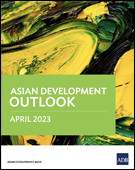 Asian Development Outlook (ADO) April 2023South Asia is projected to grow faster than other subregions in Asia, with real gross domestic product (GDP) estimated at 5.5% in fiscal year (FY) 2023 and 6.1 in FY2024. Growth within South Asia is expected to vary, with India projected to grow by 6.4% in FY2023 and 6.7% in FY2024 behind strong domestic demand. In Bangladesh, GDP growth is estimated at 5.3% in FY2023 owing to global economic disruptions and 6.5% in FY2024. In Bhutan, hydropower production will push up growth to 4.6% in FY2023 and 4.2% in FY2024. Growth in Maldives is estimated at 7.1% in FY2023 and 6.9% in FY2024, supported by a boom in tourism and construction. In Nepal, growth will slow to 4.1% this year before picking up in FY2024 at 5.0% with a recovery in tourism and infrastructure. Sri Lanka is projected to contract at -3.0% in FY2023 before recovering to 1.3% in FY2024 premised on debt relief and key reforms. In Southeast Asia, Myanmar's GDP will rise moderately to 2.8% in FY2023 and 3.2% in FY2024. Author: Asian Development Bank Year: 2023 Download Tags: South Asia, Hydropower, ADB, Bangladesh, Bhutan, India, Maldives, Myanmar, Nepal, Sri Lanka Asian Development Outlook (ADO) 2022 Supplement: Global Gloom Dims Asian ProspectsSouth Asia is projected to grow at 6.5% in fiscal year (FY) 2022 and 6.3% in FY2023. In Bangladesh, weak exports and high inflation are hampering recovery, while in Bhutan, agriculture and construction are projected to support economic growth. In India, growth is projected at 7.0% in FY2022 and 7.2% in FY2023, sustained by public reform and public and private investment. Maldives tourist arrivals and construction continue to pick up. In Nepal, the 2023 budget aims to improve agriculture, industry, and social protection. Economic contraction is expected in Sri Lanka with marked declines in industry and agriculture. In Southeast Asia, Myanmar maintains positive growth projections despite high rates of inflation. Author: Asian Development Bank Year: 2022 Download Tags: ADB, Agriculture, South Asia, Southeast Asia, Investment, Social Protection Trade and Development Report 2022South Asia is projected to expand at 4.9% in 2022 amid inflation and high energy prices. Balance of payment constraints in Bangladesh and Sri Lanka have led these countries to place restrictions on the consumption of electricity. In India, where the economy expanded by 8.2% in 2021, the easing of supply chain disruptions and the rise in domestic demand has led to a deceleration in growth. Author: United Nations Conference on Trade and Development Year: 2022 Download Tags: UNCTAD, Trade, South Asia Key Indicators for Asia and the Pacific 2022Key Indicators for Asia and the Pacific 2022 provides statistics on economic, financial, social, and environmental measures, as well as select indicators for the Sustainable Development Goals (SDGs). Statistics for Asian Development Bank's member countries include numbers for energy and electricity, transport and communications, and international trade. Author: Asian Development Bank Year: 2022 Download Tags: ADB, South Asia, Sustainable Development Goals  South Asia Economic Focus (Fall 2022) Coping with Shocks: Migration and the Road to ResilienceReal gross domestic product (GDP) in South Asia is projected to slow to 5.8% in fiscal year (FY) 2022 and FY2023. In Bangladesh, real GDP growth is projected at 6.1% in FY2022-2023, as higher inflation and rolling power outages dampen post-coronavirus economic recovery in consumption and investment. The easing of mobility restrictions is supporting Bhutan's recovery amid one of the highest vaccination rates globally. With slower domestic demand, real GDP forecast in Bhutan is set at 4.1% in FY2022-2023. In India, where exports and overall economic activity have recovered more strongly than the rest of the world, growth is forecast at 6.5% in FY2022-2023. In Maldives, real GDP is expected to grow by 12.4% in FY2022 and 8.2% in FY2023 on the recovery of tourism. Growth forecast in Nepal is set at 5.1% in FY2022-2023 amid normalization of monetary policy. Real GDP in Sri Lanka is projected at -9.2% in FY2022 and -4.2% in FY2023 due to a severe balance of payment crisis and risks posed by the country's political situation. Author: World Bank Year: 2022 Download Tags: WB, South Asia World Investment Report 2022 In 2020–2021, foreign direct investment (FDI) in South Asia fell by 26%, to $52 billion, with large mergers and acquisitions from 2020 not repeated in 2021. Flows to Bangladesh rose by 13% to $2.9 billion, while inflows to India declined to $45 billion. However, India announced new international project finance deals, including 23 in renewable energy. Outward FDI from South Asia, mainly from India, rose by 43% to $16 billion. Author: United Nations Conference on Trade and Development Year: 2022 Download Tags: UNCTAD, Trade, South Asia, Bangladesh, India, Renewable Energy  Reshaping Norms: A New Way ForwardSouth Asian countries are emerging from coronavirus (COVID-19) pandemic burdened by high inflation and fiscal imbalances, as well as external shocks. In Bangladesh, gross domestic product (GDP) is projected to increase by 6.4% in fiscal year (FY) 2021-2022 and 6.7% in FY2022-2023. In Bhutan, FY2021-2022 growth is estimated at 4.4% and FY2022-2023 growth at 4.7%, with the expected return of international tourists and migrant workers from India. In India, FY2022-2023 growth is projected at 8%, slightly below last year’s rate. Economic recovery in Maldives will stay strong in 2022, with real GDP growth expected to grow by 8.5% in 2022 and 9.1% in 2023. In Nepal, tourism has yet to recover, with growth projected at 3.7% in FY2021-2022 and 4.1% in FY2022-2023. Hydropower in Nepal is providing a natural hedge against increases in crude oil-based energy prices. Growth in Sri Lanka is hampered by a series of shocks amid high debt, with 2022 growth projected at 2.4%. Author: World Bank Year: 2022 Download Tags: WB, South Asia, Bangladesh, Bhutan, India, Maldives, Nepal, Sri Lanka Asian Development Outlook (ADO) 2021 Supplement: Recovery ContinuesSouth Asia’s economic growth is projected at 8.6% for fiscal year
(FY) 2021, while the forecast for FY2022 stands at 7.0%. In Bangladesh,
exports and imports grew due to rising global demand in clothes. In India,
gross domestic product (GDP) growth remained strong, driven by growth
in private consumption and investments. Maldives saw an increase of 193.3%
in tourist arrivals from January to October in 2021 compared with
2020. In Nepal, GDP grew by 2.5% in FY2021 due to a rebound in
services. In Sri Lanka, GDP grew by 12.3% in the second quarter of
2021, with growth prospects for 2022 downgraded due to macroeconomic
challenges. Previously, in the Asian
Development
Outlook Update, the GDP of Bhutan and Myanmar were forecast to
contract in FY2021. Author: Asian Development Bank Year: 2021 Download Tags: South Asia, Export, ADB, Import South Asia Economic Focus, Fall 2021South Asia continued to recover from the coronavirus (COVID-19) pandemic with growth set to rise by 7.1% in 2021 and 2022. Growth in Bangladesh is estimated at 6.4% in fiscal year (FY) 2021-2022 with the recovery of exports and private consumption. Bhutan GDP is projected to grow by 3.6% supported by migrant labor and public infrastructure projects. India is projected to grow by 8.3% in FY2021-2022 on the back of incentives to increase domestic demand and manufacturing. With the return of tourism in Maldives, the country’s output is expected to grow at 23.3% in 2021. Nepal GDP is estimated to grow by 3.9% as vaccination picks up and tourism and migrant worker flow recover. With pressure from the spread of the COVID-19 Delta variant in June 2021, real GDP in Sri Lanka is projected to grow by 3.3% in 2021. Author: World Bank Year: 2021 Download Tags: South Asia, WB, COVID-19 Key Indicators for Asia and the Pacific 2021Key Indicators for Asia and the Pacific 2021 provides updated statistics on economic, financial, social, and environmental measures as, well as select indicators for the Sustainable Development Goals (SDGs). Statistics are for 49 regional members of the Asian Development Bank, including numbers for energy and electricity, transport and communications, and international trade. Author: Asian Development Bank Year: 2021 Download Tags: ADB, South Asia, Sustainable Development Goals Asian Development Outlook 2021 UpdateEconomic growth in South Asia is projected at 8.8% in 2021 while the outlook for next year has been raised to 7.0% from 6.6%. In Bangladesh, growth in fiscal year (FY) 2022 is projected to strengthen though still below pre-coronavirus pandemic levels. In Bhutan, gross domestic product (GDP) in FY2021 is estimated to have contracted by 3.4%; growth is forecast to rebound to 3.7% in FY2022. The projection for India is downgraded to 10.0% from the earlier projection of 11.0% in FY2021, while the outlook for FY2022 improved to 7.5% from 7.0%. Tourist arrivals in Maldives increased by 33.4% year on year in 2021. In Nepal, GDP growth is estimated at 2.3% in FY2021. In Sri Lanka, GDP growth forecasts are revised down to 3.4% in 2021 with risks from fresh pandemic outbreak and currency related stress. Author: Asian Development Bank Year: 2021 Download Tags: ADB, COVID-19, South Asia, Bangladesh, Bhutan, India, Maldives, Sri Lanka World Investment Report 2021Global flows of foreign direct investment fell by one third to $1 trillion in 2020 due to the coronavirus disease (COVID-19) pandemic. In South Asia, foreign direct investments rose by 20% to $71 billion in 2020, driven mainly by strong mergers and acquisitions in India. Inflows in Bangladesh contracted by 11% and in Sri Lanka by 43%, where inflows will take longer to recover. This report monitors global and regional investment trends to support national and international policymakers. Author: United Nations Conference on Trade and Development Year: 2021 Download Tags: COVID-19, Bangladesh, India, Sri Lanka, FDI, South Asia, Sustainable Development Goals, UNCTAD Beyond the Pandemic: Building Back Better from Crises in Asia and the PacificThe coronavirus disease (COVID-19) pandemic has interrupted trade and tourism worldwide, leading to job losses and rising poverty. Countries need to address weaknesses in economic and social protection systems, through national initiatives that can be supported by regional cooperation. United Nations Economic and Social Commission for Asia and the Pacific member countries endorsed the Action Plan to Strengthen Regional Cooperation on Social Protection in Asia and the Pacific. This provides a platform through which governments in South Asia could work together to help mitigate the impacts of the pandemic. Author: United Nations Economic and Social Commission for Asia and the Pacific Year: 2021 Download Tags: COVID-19, Regional Cooperation, South Asia, Trade, Tourism Asian Development Outlook (ADO) 2021 Supplement: Renewed Outbreaks and Divergent RecoveriesGrowth forecast for South Asia has been downgraded to 8.9% for 2021, dampened by new surges of coronavirus disease (COVID-19) infections. Growth in exports and remittances backed economic activity in Bangladesh. In Bhutan, economic activity has slowed after local containment measures were enacted to control the spread of COVID-19. India's growth projection has been downgraded to 10.0% from 11.0% in 2021. Weak travel demand in Maldives and persistent infections in Nepal are hampering recovery in those countries. In Sri Lanka, restrictions brought about by a third wave of infections are slowing down tourism and other economic activity. With businesses and consumers in South Asia better able to adapt to containment measures, the adverse economic impact of COVID-19 surges is expected to be limited. Author: Asian Development Bank Year: 2021 Download Tags: COVID-19, Tourism, South Asia The Recover Better with Sustainable Energy Guide for South Asian CountriesThis guide under the Recover Better series from Sustainable Energy for All (SEforALL) highlights ways in which countries could attain long-term sustainable development. This report recommends South Asian countries to develop regional value chains through the South Asian Association for Regional Cooperation (SAARC) regional energy cooperation framework. The framework would help reduce costs and increase energy system resilience. By deepening cooperation, South Asian countries involved in the electricity trade would also reap many technical, economic, and environmental benefits. Author: Sustainable Energy for All Year: 2020 Download Tags: Renewable Energy, South Asia The Least Developed Countries Report 2020: Productive Capacities for the New DecadeThe coronavirus disease (COVID-19) pandemic is taking its toll on economies of least developed countries (LDCs). To help economies and aid their recovery from the pandemic, this report lays out proposed measures for improving productive capacities of LDCs. It looks at mechanisms for regional cooperation in the areas of green technologies, industry, and digital technologies. The report takes a look at regional integration schemes, such as the South Asian Free Trade Area, and discusses how these could be instrumental in the sustainable and inclusive recovery for LDCs. Author: United Nations Conference on Trade and Development Year: 2020 Download Tags: South Asia, UNCTAD, Least Developed Countries, Regional Cooperation, SAFTA 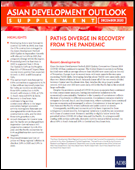 Asian Development Outlook (ADO) 2020 Supplement: Paths Diverge in Recovery from the PandemicThis publication provides updated economic forecasts for Asia and the Pacific. In South Asia, the earlier forecast of 6.8% contraction in 2020 is upgraded to 6.1%. Growth in South Asia is expected to return in 2021 at 7.2%. This is in line with improved prospects for India, where contraction is projected at 8.0% in 2020 and growth is projected at 8.0% in 2021. In Bangladesh, growth in exports and remittances backed economic activity. In Bhutan, the impact of the coronavirus disease (COVID-19) pandemic is expected to be greater than projected. Travel demand remains weak in Maldives and is hampering recovery. In Nepal, a persistent rise in COVID-19 infections holds back demand. Resurgent outbreaks in Sri Lanka’s export and tourist markets are expected to worsen contraction in 2020. Author: Asian Development Bank Year: 2020 Download Tags: South Asia, India, Bhutan, Sri Lanka, Nepal, Bangladesh, Maldives, Tourism, COVID-19, Export New Approaches to Measuring and Assessing Regional Cooperation and Integration: Workshop HighlightsThis publication presents highlights from the Asian Development Bank (ADB) workshop on regional cooperation and integration on 16 and 17 April 2020. Discussions focused on approaches to measuring RCI and its implications for policy assessment. Mr. Ronald Antonio Butiong, Director, Regional Cooperation and Operations Coordination Division, South Asia Department, ADB, discussed regional integration indicators in South Asia Subregional Economic Cooperation (SASEC) member countries and outlined priorities for enhancing economic growth, improving social inclusion, and tackling poverty. Author: Asian Development Bank Year: 2020 Download Tags: Regional Cooperation, South Asia, SASEC, ADB, ADB RCI World Trade Statistical Review 2020 World Trade Statistical Review 2020 presents the latest developments in world trade, with analysis of recent trends for trade in goods and services. The report examines the impact of the coronavirus disease (COVID-19) pandemic on international trade, and provides data on trade in least developed countries as well as in countries under the South Asian Free Trade Area. Author: World Trade Organization Year: 2020 Download Tags: SAFTA, South Asia, Trade Facilitation, Unleashing E-Commerce for South Asian IntegrationE-commerce is changing how transactions are made for goods and services. E-commerce facilitates international trade by reducing transaction costs. It also has the potential to be more inclusive of women, small businesses, and rural entrepreneurs. This report considers how e-commerce can be improved to deepen intraregional trade in South Asia. It looks at digital transacting models that reduce transaction costs and gives recommendations for regulatory reforms that could expand global participation by South Asian firms. Author: Sanjay Kathuria, Arti Grover, Viviana Maria Eugenia Perego, Aaditya Mattoo, and Pritam Banerjee Year: 2020 Download Tags: South Asia, Regional Cooperation, Regional Integration, Trade Facilitation Review of the ADB Clean Energy ProgramThis publication presents a review of the Clean Energy Program of the Asian Development Bank (ADB). It looks at what needs to be done in light of goals of mitigating climate change and promoting sustainable development. It also looks at the goals in terms of ADB’s Strategy 2030. Fostering regional cooperation and integration is among the operational priorities ADB has identified in Strategy 2030. ADB operations in the energy sector has promoted energy connectivity—such as through power interconnections in South Asia—and sharing best practices and technologies in renewable energy development. Author: Asian Development Bank Year: 2020 Download Tags: ADB, Energy, South Asia, Renewable Energy ADB Annual Report 2019The Asian Development Bank (ADB) 2019 Annual Report details ADB’s operations, activities, and financial results over the year. ADB helps foster regional cooperation and integration through its support of the SASEC Program. In 2019, ADB committed $495 million to reduce travel times along regional corridors connecting Nepal with India and Bangladesh and improve connections to Sri Lanka’s international port under the SASEC Program. Author: Asian Development Bank Year: 2020 Download Tags: ADB, SASEC, South Asia, Regional Cooperation Infrastructure Financing in AsiaThis book discusses how private financing can help address Asia’s infrastructure investment needs. In South Asia, public spending and public-private partnerships (PPP) may be leveraged for large infrastructure needs. Challenges that arise from each source of infrastructure financing—such as the long-term nature of PPP contracts—need to be addressed. Author: Asian Development Bank Year: 2019 Download Tags: ADB, South Asia Review of Maritime Transport 2019According to this report, total volume of global maritime trade reached an all-time high of 11 billion tons in 2018. However, growth was at 2.7%, below previous averages. In South Asia, the 10 most connected ports are in Sri Lanka, India, and Pakistan. Among which, the most connected port is Colombo in Sri Lanka, which serves as a transshipment hub for the region. The Mundra port in India saw the largest increase in the liner shipping connectivity index. Chittagong in Bangladesh is the world’s 14th most connected port, while Male in Maldives is 18th. Author: United Nations Conference on Trade and Development Year: 2019 Download Tags: South Asia, Sri Lanka, Ports, Trade Doing Business 2020From May 2018 to May 2019, 294 regulatory reforms were implemented worldwide to make it easier to do business. India was among the countries that showed the most notable improvement in doing business during the period. South Asia had the highest share of economies that implemented cross-border cooperation reform, which ensures easy customs clearance procedures, harmonization of compliance rules, and border control efficiency. For example, Nepal opened a new integrated check post with India, thereby decreasing the time to import and export. Author: World Bank Group Year: 2019 Download Tags: WB, Ease of Doing Business, Customs, South Asia, Harmonisation Asian Development Outlook (ADO) 2019 Supplement, December: Growth Slows Further in Developing Asia’s GiantsDeveloping Asia's gross domestic product is projected to grow by 5.2% both in 2019 and 2020 as a slowing of global economic activity tempers regional growth, according to the Asian Development Outlook (ADO) 2019 Supplement. In South Asia, growth forecasts have been lowered to 6.1% in 2020. Strong remittances in Bangladesh will raise domestic demand, while in Bhutan, hydropower production rose to 3.1% in Q1 of FY2020 (ending 30 June 2020). Growth in India is expected to recover to 6.5% in 2020 with government policy measures, such as a corporate tax cutt and policy rate reduction. In Maldives, tourism remains strong. Foreign direct investments surged in Nepal while a recovery in economic activity is projected in Sri Lanka. Author: Asian Development Bank Year: 2019 Download Tags: ADB, South Asia, Hydropower, Tourism, Investment, Bangladesh, Bhutan, Maldives, Nepal, Sri Lanka 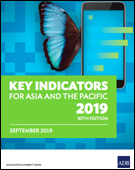 Key Indicators for Asia and the Pacific 2019This report presents the latest economic, financial, social, and environmental statistics, and includes sustainable development goals indicators, for the 49 regional members of the Asian Development Bank (ADB). Remittances have been a stable source of revenue for Asia and the Pacific, with India being the top recipient of remittances globally at $78.6 billion in 2018. In 2017, foreign direct investment (FDI) in the region rose to $541.9 billion, although FDI flows have been more volatile compared to remittance flows. This report uses domestic value-added via forward linkages (DVA_F) to discuss the evolution of global value chains in Asia. In 2018, almost a third of the DVA_F generated in Asia stayed within the region, representing 39.0% of the total domestic value-added sent to the region. It shows the importance of intraregional trade for Asia, as Asia's trade connection to North America is weakening. Author: Asian Development Bank Year: 2019 Download Tags: ADB, India, South Asia, Sustainable Development Goals, Trade Asia-Pacific Trade Facilitation Report 2019: Bridging Trade Finance Gaps through TechnologyThis report reviews the progress of trade facilitation in Asia and the Pacific. It looks at recent trends in paperless trade and transit facilitation and the impact of trade facilitation initiatives on trade costs. The Global Survey on Digital and Sustainable Trade Facilitation shows significant progress toward streamlining trade procedures in the Asia and the Pacific. In South Asia, the average implementation rate of trade facilitation procedures in 2019 is at 55.4%. The report features a special chapter on how trade finance gaps—especially prevalent for small and medium-sized enterprises—can be bridged by technology. Author: Asian Development Bank and United Nations Economic and Social Commission for Asia and the Pacific Year: 2019 Download Tags: Small and Medium Enterprise, South Asia, Trade Facilitation Global Economic Prospects, June 2019South Asia enjoyed solid economic activity in 2018 with gross domestic product (GDP) growth at 7% owing to strong domestic demand. Risks to the outlook include possible re-escalation of political uncertainties, financial sector weaknesses due to nonperforming assets, and fiscal challenges amid elections in several countries. Author: World Bank Group Year: 2019 Download Tags: WB, South Asia, Trade World Investment Report 2019This report monitors global and regional foreign direct investment trends and national and international investment policy developments. Foreign direct investments (FDI) in South Asia grew by 4% in 2018 to $54 billion, with India accounting for $42 billion. International cooperation in the development of special economic zones (SEZs) has been increasing. In developing countries, many SEZs are built through bilateral partnerships or as part of development cooperation programs. In South Asia, the number of SEZs is set to increase substantially. India has 200 new zones in the pipeline, while Bangladesh has 60, and Nepal 12. Author: United Nations Conference on Trade and Development Year: 2019 Download Tags: Bangladesh, India, Nepal, FDI, Investment, South Asia, UNCTAD Exports to Jobs: Boosting the Gains from Trade in South Asia South Asia’s economy has grown while significantly reducing poverty. Yet concerns persist regarding growing joblessness and poor job quality. This report shows how increasing exports per worker could result in higher wages for skilled workers, while less-skilled and rural workers could benefit from new jobs. To spread benefits from higher exports, policies are needed to raise skills and get women and youth into better jobs. Author: Erhan Artuc, Gladys Lopez-Acevedo, Raymond Robertson, and Daniel Samaan Year: 2019 Download Tags: South Asia, Jobs, Trade Asian Development Outlook (ADO) 2019: Strengthening Disaster ResilienceDeveloping Asia is projected to grow at 5.7% in 2019 and 5.6% in 2020. South Asia is projected to bounce back in 2019 and 2020 from the previous year’s slowdown. India’s growth is expected to pick up to 7.2% in 2019 (from 7.0% in the previous year) on recovery in agriculture and strong domestic demand. Bangladesh is projected to grow by 8.0% in 2019. Bhutan is expecting modest growth while the outlook for Maldives is for growth to moderate. Nepal should expect stable growth in 2019 while Sri Lanka is projected to recover moderately. Inflation in South Asia is projected to rise to 4.7% in 2019. Growth should pick up in Myanmar in Southeast Asia. Author: Asian Development Bank Year: 2019 Download Tags: ADB, South Asia, Bangladesh, Bhutan, India, Myanmar, Maldives, Nepal, Sri Lanka Review of Maritime Transport 2018Around 80% of volume of global trade are carried by sea and are handled by ports. According to this report, global maritime trade experienced its fastest growth in five years. Prospects for maritime trade are bright. However risks exist in the form of trade frictions, the global energy transition, etc. The report states that technological advances including artificial intelligence, blockchain applications, the internet of things, and autonomous ships and drones could potentially boost efficiency in global shipping. Author: United Nations Conference on Trade and Development Year: 2018 Download Tags: Cooperation, South Asia, Transport Asia-Pacific Trade and Investment Report 2018: Recent Trends and DevelopmentsThe Asia-Pacific Trade and Investment Report provides information and independent analyses of regional trends and policy developments in trade, goods, and commercial services. In 2018, the Asia-Pacific region increased its share of global merchandise trade. Intraregional and interregional trade also accelerated in Asia-Pacific. As trade among and with North, Central, and South Asia still involve high costs, more cooperation is needed on digitalization of trade processes. Author: United Nations Economic and Social Commission for Asia and the Pacific Year: 2018 Download Tags: South Asia, Trade Facilitation Agreement, WTO, SAARC, UNESCAP Doing Business 2019: Training for ReformA record 314 reforms were undertaken around the world, serving to improve business climate in the past year. South Asian economies carried out 19 reforms, many of which focused on improving starting a business, access to credit, paying taxes, and resolving insolvency. South Asia scored the highest for trading across borders. India continued its reform agenda and advanced 23 slots to 77th place in the global ranking, making it South Asia’s top-ranked economy. Bhutan introduced an online platform for filling corporate and personal income tax. Sri Lanka climbed to 100th place after instituting reforms on paying taxes and enforcing contracts. Author: World Bank Group Year: 2018 Download Tags: Ease of Doing Business, South Asia, Trade Facilitation, WB World Energy Trilemma Index 2018Using global and national data, this report presents a ranking of countries’ energy performance in terms of energy security, energy equity, and environmental sustainability. The rankings show impacts of decisions and changes to suggest policy innovation that could help countries successfully navigate the energy transition. In South Asia, India was noted for increasing diversity of its energy generation while trying to meet rising demand. Bhutan attained 100% electrification in 2016, while Bangladesh increased energy access from 55% to 76% from 2014 to 2018, largely due to the use of micro and mini solar power systems. Nepal has achieved 91% electricity access and is on track to achieving 100% electrification by 2030. Author: World Energy Council Year: 2018 Download Tags: Energy, South Asia World Trade Report 2018: The Future of World TradeThe report looks at international trade and analyzes how digital technologies will reduce trade costs. It examines the internet of things, artificial intelligence, 3-D printing and blockchain, and speculates how these things will affect global trade in the next 15 years. It looks at indicators on South Asia and other regions to help evaluate each region’s preparedness for the digital age. Author: World Trade Organization Year: 2018 Download Tags: South Asia, Trade Facilitation Agreement, WTO World Investment Report 2018In India, foreign direct investment (FDI) inflows dropped from $44 billion in 2016 to $40 billion in 2017. Across South Asia, FDI inflows are predicted to stagnate or decline marginally in 2018. The global trend in FDI flows demonstrates the need for open, transparent, and non-discriminatory investment policies to maintain an environment conducive for investment. New types of industrial policies are emerging to respond to opportunities and challenges brought about by a new industrial revolution. This report examines investment policy tools available in the new environment. Author: United Nations Conference on Trade and Development Year: 2018 Download Tags: Connectivity, FDI, Global Value Chains, India, Investment, Policy, Sustainable Development Goals, South Asia, UNCTAD Asian Development Outlook (ADO) 2018 Update: Maintaining Stability Amid Heightened UncertaintyThis Update forecasts 6.0% growth for the region in 2018 and 5.8% in 2019. In South Asia, economic outlook remains optimistic. The region is expected to sustain its growth momentum, and meet projections of 7.0% in 2018 and 7.2% in 2019. Forecast for India is maintained at 7.3% in 2018 and 7.6% in 2019. Robust investment climate in Bangladesh is driving projections from 7.0% to 7.9% in 2018 and 7.2% to 7.5% in 2019, and in Nepal, from 4.9% to 5.9% in 2018. A drop in domestic demand lowers growth projections for Bhutan, from 7.1% to 6.7% in 2018 and 7.4% to 7.1% in 2019, and Sri Lanka, from 4.2% to 3.8% in 2018 and 4.8% to 4.5% in 2019. Author: Asian Development Bank Year: 2018 Download Tags: South Asia, India, Bangladesh, Nepal, Sri Lanka, ADB, Bhutan How Would Cross-Border Electricity Trade Stimulate Hydropower Development in South Asia?South Asia uses only 20% its hydropower potential, estimated at more than 350 gigawatts. This report looks at regional electricity trade and examines the potential of hydropower development and trade in the region. It studies the importance of improving cross-border transmission interconnections to promote hydropower in South Asia. It also shows that large hydropower development would provide the additional benefits of irrigation and flood control that can be shared among neighboring countries, such as Bangladesh, India, and Nepal. Author: Govinda R. Timilsina Year: 2018 Download Tags: Bangladesh, Energy, Hydropower, Nepal, Regional Cooperation, South Asia, Trade Global Energy Transformation: A Roadmap to 2050The report details the needed energy technologies and analyzes the costs and benefits of energy transition in Asia and the rest of the world. All regions are projected to experience high growth in gross domestic product from the energy transformation. Mexico, Brazil, and India are expected to post the highest welfare gains, where pollution’s impact on health is projected to fall sharply. To accelerate the energy transition, governments could establish more bilateral and multilateral demonstration projects and encourage development of internationally harmonized technical standards to facilitate cross-border trade and exchange of technologies. Author: International Renewable Energy Agency Year: 2018 Download Tags: Climate Change, Renewable Energy, India, South Asia Financing Infrastructure in Asia and the Pacific: Capturing Impacts and New SourcesThis book looks at the impact of infrastructure investment on economic and social indicators, and shows how infrastructure investment can increase output, taxes, trade, and firm productivity. One study in the book shows that trade facilitation reforms in South Asia resulted in increased intraregional trade and trade with other regions. The book proposes innovative modes of financing for infrastructure needed to drive sustainable growth. Author: Naoyuki Yoshino, Matthias Helble, and Umid Abidhadjaev (editors) Year: 2018 Download Tags: ADB, Infrastructure, Services, South Asia, Trade Facilitation ADB Annual Report 2017The Asian Development Bank (ADB) 2017 Annual Report details ADB’s operations, activities, and financial results over the year. In South Asia, finance ministers from South Asia Subregional Economic Cooperation (SASEC) member countries launched the SASEC Vision, which sets a long-term strategy for inclusive growth for the region. ADB also signed seven SASEC projects worth a combined $1.33 billion, bringing SASEC’s cumulative investment portfolio to $10.72 billion. ADB helped form SASEC working groups for cross-border trade and supported economic corridors in Bangladesh, India, and Sri Lanka to facilitate trade and investment in South Asia. Author: Asian Development Bank Year: 2018 Download Tags: ADB, Bangladesh, Bhutan, India, Regional Cooperation, SASEC, South Asia Harmonizing Electricity Laws in South AsiaMany in South Asia face electricity shortages that affect their socioeconomic development. But the region has a large hydropower potential and other energy resources that may be harnessed to drive growth in the region. This report looks at legal, regulatory, technical, and commercial requirements for energy trade to advance in the region, and gives recommendations for implementing the South Asian Association for Regional Cooperation Framework Agreement on Energy Trade. Author: Asian Development Bank and the South Asian Association for Regional Cooperation in Law Year: 2017 Download Tags: Bangladesh, Bhutan, Energy, Harmonisation, India, Industrialization, Maldives, Nepal, Regional Cooperation, South Asia, Sri Lanka, Trade, ADB RCI Extra Time: Trade Insight, Vol. 13 No. 2, 2017Trade Insight is published by the South Asia Watch on Trade, Economics and Environment. This issue’s main feature examines the special and differential treatment (S&D) provisions, which give least developed countries flexibilities in implementing WTO Agreements. The issue also includes features on trade integration among landlocked developing countries and the proposal to facilitate trade in services. Author: South Asia Watch on Trade, Economics and Environment Year: 2017 Download Tags: Regional Integration, South Asia, Trade Facilitation Agreement, WTO How Strategic Are Trade Strategies? Trends for Effective DevelopmentThis paper looks at 1,454 trade strategies in the International Trade Centre’s Trade Strategy Map, the world’s largest collection of documents on trade and development. It identifies key trends in trade and development strategies from 169 countries and highlights the need to ensure coherence among domestic and multilateral strategies in the coming years. Author: International Trade Centre Year: 2017 Download Tags: Trade, South Asia Asia-Pacific Trade and Investment Report 2017: Channelling Trade and Investment into Sustainable DevelopmentThis report provides analyses of trends and policy developments in trade in goods and commercial services in Asia-Pacific. It shows that merchandise trade remained subdued in 2016, with South and Southwest Asia accounting for 8% of Asia-Pacific exports and 12% of Asia-Pacific imports. Foreign direct investments inflows In South and South-West Asia decreased slightly by 4% to $66 billion in 2016. The report also argues for targeted trade and investment policies that strike a balance between economic development and social and environmental development. Author: United Nations Economic and Social Commission for Asia and the Pacific Year: 2017 Download Tags: Trade, Investment, FDI, ASEAN, India, Services, South Asia, Sri Lanka, Sustainable Development Goals, UNESCAP 2017 Handbook of StatisticsThis report presents statistics and indicators on international trade, investment, and development. It includes data on developing economies in South Asia, which in 2016 accounted for about $401 billion in merchandise exports and $529 billion in merchandise imports, $192 billion in service exports and $175 billion service imports, and 6.7% gross domestic product (GDP) growth. Author: United Nations Conference on Trade and Development Year: 2017 Download Tags: FDI, South Asia, Trade, Transport, UNCTAD Doing Business 2018: Reforming to Create JobsDoing Business, an annual publication of the World Bank, presents quantitative indicators on business regulations that can be compared across 190 economies and over time. The report finds that entrepreneurs in 119 economies saw improvements in their local regulatory framework, including reforms for reducing complexity in regulatory processes for starting businesses. South Asia scores well for starting a business, though it scores only an average of 33.04 for resolving insolvency. India has the highest score in South Asia for protecting minority investors. Patterns show further room for improvement across all regions and at all income levels. Author: World Bank Group Year: 2017 Download Tags: Ease of Doing Business, South Asia, WB 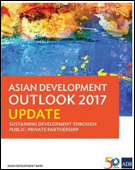 Asian Development Outlook (ADO) 2017 Update: Sustaining Development through Public-Private PartnershipDeveloping Asia is forecast to expand by 5.9% in 2017 and 5.8% in 2018, a slight upgrade from projections in the Asian Development Outlook 2017. However, growth forecast for South Asia is downgraded to 6.7% in 2017. India’s growth remains strong and most South Asian countries are expected to meet or exceed growth forecasts from April. Exceptions are Sri Lanka, where agriculture was affected by drought and floods, and Bhutan, where geological problems have constrained construction on two large hydropower projects. Growth in Nepal surged in 2017 on earthquake recovery but is slowing as agriculture struggles, following severe flooding in August 2017. Inflation forecast in South Asia is lowered to 4.2% for 2017 and 4.7% for 2018. Favorable global commodity prices, good harvests, and prudent macroeconomics are expected. Author: Asian Development Bank Year: 2017 Download Tags: Asia, Development, Sustainability, Public Private Partnerships, South Asia, India, Sri Lanka, Agriculture, Bhutan, Hydropower, Energy, Nepal World Development Indicators 2017This report compiles statistics on global development, with this years’ database including more indicators covering the Sustainable Development Goals and more data disaggregated by sex, age, wealth quintile, and urban or rural location. The online database (http://data.worldbank.org) now includes more than 1,400 indicators for more than 220 economies (including those from South Asia), with some data series extending back more than 50 years. Author: World Bank Year: 2017 Download Tags: WB, Development, Sustainable Development Goals, South Asia World Trade Report 2017: Trade, Technology, and JobsEconomic growth over the last 25 years has been accompanied by unprecedented economic change. Over the past two decades, many countries have experienced significant transformations in the sectoral and occupational structure of employment. This report examines how technology and trade affect employment and wages and analyzes the challenges for workers and firms in adjusting to changes in labor markets. It looks at how governments could increase the positive impact of open trade and technological trade in South Asia and around the world. Author: World Trade Organization Year: 2017 Download Tags: Trade, ICT, Employment, Global Value Chains, South Asia 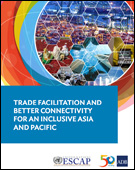 Trade Facilitation and Better Connectivity for an Inclusive Asia and PacificThis report investigates the evolution of trade costs, examines trade facilitation and paperless trade implementation, and highlights key initiatives in South Asia, including efforts by members of the South Asia Subregional Economic Cooperation (SASEC). The SASEC Trade Facilitation and Transport Working Group agreed to expand assistance to trade facilitation through technical assistance to support more efficient, transparent, secure, and service-oriented processing of cross-border trade across South Asia. Through 2025, the SASEC connectivity agenda will be better aligned with the frameworks of South Asian Association for Regional Cooperation and the Bengal Initiative for Multi-Sectoral Technical and Economic Cooperation. To help establish a trade and transport facilitation monitoring mechanism, Bangladesh, Bhutan, and Nepal conducted studies that reviewed trade and transport procedures, analyzed bottlenecks, and gave recommendations on trade and transport facilitation. Author: Asian Development Bank and United Nations Economic and Social Commission for Asia and the Pacific Year: 2017 Download Tags: ADB, Bangladesh, Bhutan, BIMSTEC, Maldives, Nepal, SAARC, India, Myanmar, SASEC, South Asia, Sri Lanka, Trade Facilitation, Transport, UNESCAP, ADB RCI Together We Deliver: 50 Stories of ADB's Partnerships in Asia and the PacificThis special edition of Together We Deliver tells 50 stories that highlight the importance of good partnerships in Asia and the Pacific in meeting complex development challenges. In South Asia, ADB has supported infrastructure development and social programs, helping lift people out of poverty in a diverse, rapidly urbanizing subregion. The South Asia Subregional Economic Cooperation Roads Improvement Project, for instance, is set to widen 160 kilometers of Nepal’s East–West Highway, which connects Nepal to India. The improved roads will provide faster and better access to social services and economic opportunities, and will facilitate national and regional integration. Author: Asian Development Bank Year: 2017 Download Tags: ADB, Economic Corridor Development, India, Nepal, Regional Integration, Roads, SASEC, South Asia, Transport State of Electricity Access Report (SEAR) 2017This report presents insights drawn from emerging innovative business and delivery models so that governments, donors, the private sector, civil society organizations, and practitioners could develop interventions to close the electricity access gap. It shows that urgent measures are needed to speed up access to modern energy services in Sub-Saharan Africa and South Asia and that responses will have to be supported by a conducive environment of the right institutions, policies, strategic planning, and incentives. Author: World Bank Year: 2017 Download Tags: Energy, South Asia, Sustainable Development Goals SARSO News: Vol. 31, No. 2The South Asian Regional Standards Organization (SARSO) newsletter features updates on SARSO events and activities. This issue features the publication of three South Asian Association for Regional Cooperation standards on food quality and safety, and the workshop on the importance of ISO 14001—which aims to help organizations improve environmental performance through the efficient use of resources and reduction of waste—and its impact on the environment and trade. It also has reports on Workshop on Conformity Standards held in New Delhi, India, and the Enhancing Capacity for Sanitary and Phytosanitary (SPS) Measures for Safe Trade in Animal and Animal Products in South Asia held in Kathmandu, Nepal. Author: South Asian Regional Standards Organization Year: 2017 Download Tags: Agriculture, Bangladesh, Bhutan, India, Nepal, SAARC, SARSO, South Asia, Standardization, Trade Asian Development Outlook (ADO) 2017 Supplement: Cautious Optimism for Asia's OutlookWith export demand stronger than expected in the first quarter of 2017, Asia’s GDP is expected to expand faster than forecast in April in Asian Development Outlook 2017. Developing Asia is now expected to grow by 5.9% in 2017. The smaller upgrade in the 2018 growth forecast—5.7% in ADO 2017 to 5.8%—reflects a cautious view on the pace of the turnaround in external demand. Excluding the newly industrialized economies, growth projections for the region are revised up to 6.4% for 2017 and to 6.3% for 2018. India is expected to achieve April forecasts of 7.4% growth in 2017 and 7.6% in 2018, primarily from strong consumption. Growth projections for South Asia are likewise maintained as prospects remain robust. Author: Asian Development Bank Year: 2017 Download Tags: ADB, Development, Export, Bangladesh, India, South Asia World Trade Statistical Review 2017The World Trade Statistical Review looks at the last 10 years and examines the latest developments in world trade, with a detailed analysis of the most recent trends for trade in goods and services. The book gives information on the participation of India, Bangladesh, and other South Asian economies in world trade, and highlights trends in the use of trade-facilitating measures. It also gives information on the implementation of the WTO Trade Facilitation Agreement and regional trade agreements, such as the South Asian Free Trade Arrangement. Author: World Trade Organization Year: 2017 Download Tags: Export, Least Developed Countries, Aid for Trade, SAFTA, South Asia, Trade Facilitation, WTO, Bangladesh, Bhutan, India, Maldives, Myanmar, Nepal, Sri Lanka Win-Win: How International Trade Can Help Meet the Sustainable Development GoalsThis book aims to demonstrate to policy makers how international trade can contribute to achieving the Sustainable Development Goals (SDGs). Trade can promote income growth, which can then support sustainable development. In addition, there are also direct links between trade and sustainable development, such as trade’s effect on the price and availability of health, education, energy, and other important services. This book maps out a triple-win scenario where good trade policy spurs international trade, contributes to development-friendly outcomes, and helps achieve the SDGs. Author: Matthias Helble and Ben Shepherd, eds. Year: 2017 Download Tags: Bangladesh, India, Maldives, Nepal, Services, South Asia, Sustainability, Sustainable Development Goals World Investment Report 2017This report presents foreign direct investment (FDI) trends and prospects at global, regional and national levels. FDI flows to developing Asia contracted by 15% to $443 billion in 2016. This decline was relatively widespread, except in South Asia, where several countries including Bangladesh and Nepal are expected to receive more FDI in the coming years. The report investigates the internationalization patterns of digital multinational enterprises, as well as the effect of digitalization on global companies across all industries. It provides insights to policymakers on how the digital economy impacts investment policies and how investment policy can support digital development, with a view toward achieving the SDGs. Author: United Nations Conference on Trade and Development Year: 2017 Download Tags: FDI, Global Value Chains, Investment, Policy, South Asia, UNCTAD, Bangladesh, India, Nepal 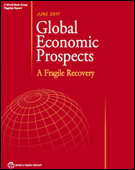 June 2017 Global Economic Prospects: A Fragile RecoveryThe World Bank forecasts that global growth will strengthen to 2.7% in 2017 amid a pickup in manufacturing and trade, rising confidence, favorable global financing conditions, and stabilizing commodity prices. In South Asia, growth is projected to remain strong at 6.8% in 2017. India is recovering from the temporary adverse effects of the end-2016 withdrawal of large-denomination currency notes. Activity in Bangladesh is moderating, reflecting a pullback in domestic demand and industrial production. Regional growth is expected to steady in 2018-2019, reaching an average of 7.2%, supported by strong domestic demand, a small rise in exports, and strong foreign direct investment. The regional outlook has been slightly revised down from January, reflecting a more protracted recovery in private investment in India than previously expected. Author: World Bank Group Year: 2017 Download Tags: WB, Bangladesh, FDI, India, Manufacturing, South Asia, Trade 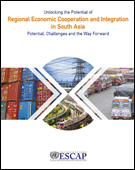 Unlocking the Potential of Regional Economic Cooperation and Integration in South AsiaAt a modest 6% of total trade, intraregional trade in South Asia stands at less than one third of its full potential. Trade barriers and inadequate infrastructure have cost South Asia over US $54 billion per year in lost export opportunities. With 309 million people living on less than $1.90 a day—the largest concentration of poverty in the world—South Asia should urgently pursue broad-based regional economic cooperation that could enable effective responses to the subregion’s developmental challenges. This report examines the state of economic integration in South Asia and identifies potential areas for further strengthening subregional linkages. It provides recommendations on policy actions to increase market integration, improve connectivity, boost investment in infrastructure development, and tackle shared vulnerabilities and risks. It calls for the consolidation and upgrading of existing trade and investment cooperation initiatives into a South Asia Comprehensive Economic Partnership. Author: United Nations Economic and Social Commission for Asia and the Pacific Year: 2017 Download Tags: BIMSTEC, Investment, Regional Cooperation, SAARC, South Asia, Sustainability, Sustainable Development, Trade, UNESCAP, Bangladesh, Bhutan, India, Maldives, Myanmar, Nepal, Sri Lanka Growth Slowdowns, Middle-Income Trap, and Demographic Profile in South AsiaThis paper examines how investment in human capital is critical for innovation. Analyzing the different growth-promoting factors in South Asian economies, with a focus on demographics, and factors that can help shift middle-income countries to high-income countries, it concludes that economic transition is affected by firms’ productive advantages—ability to compete with high-skilled producers, low-wage exporters—and education-based growth, which can help advance the country's technological capacity. Author: S. P. Jayasooriya Year: 2017 Download Tags: Economics, Employment, Manufacturing, Economic Corridor, South Asia 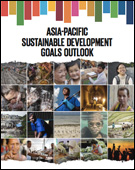 Asia-Pacific Sustainable Development Goals OutlookThis outlook report on the Sustainable Development Goals (SDG) offers an overview of the issues confronting the Asia and the Pacific region in eradicating poverty. Calling for greater synergies and collaboration, this report underscores that climate change and growth policies, including initiatives to improve access to energy and other forms of infrastructure, must also correspond to poverty-reduction strategies. The first knowledge product under a renewed partnership between the Economic and Social Commission for Asia and the Pacific, the Asian Development Bank, and the United Nations Development Programme, this report brings together experts and practitioners in the hope of inspiring new ideas to achieve the 2030 agenda. Author: United Nations Economic and Social Commission for Asia and the Pacific, Asian Development Bank, and United Nations Development Programme Year: 2017 Download Tags: Regional Cooperation, Trade Facilitation, Poverty Reduction, South Asia The Little Data Book on Information and Communication TechnologyThis book presents quick indicators for more than 200 countries showing data on key indicators of information and communications technology (ICT), including access, quality, affordability, efficiency, sustainability, and applications. It includes data for Bangladesh, Bhutan, India, Maldives, Myanmar, Nepal, and Sri Lanka. Author: World Bank and International Telecommunications Union Year: 2017 Download Tags: Bangladesh, Bhutan, ICT, India, Maldives, Myanmar, Nepal, Sri Lanka, South Asia, WB ADB Annual Report 2016The Asian Development Bank (ADB) 2016 Annual Report provides a complete picture of ADB’s performance in the reporting year. In 2016, South Asia sustained its rapid economic growth, expanding by 6.6% despite global headwinds. ADB approved $4.4 billion in loans and grants covering 30 projects in South Asia. ADB also supported the development of the South Asia Subregional Economic Cooperation (SASEC) Vision, which articulates the region’s potential as an integrated entity. SASEC countries adopted the partnership’s first comprehensive and long-term Operational Plan covering 2016-2025, defining strategic objectives and operational priorities. The Operational Plan identifies over 200 potential projects requiring more than $120 billion in development assistance over the next five years. Author: Asian Development Bank Year: 2017 Download Tags: ADB, SASEC, South Asia 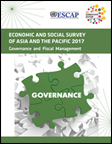 Economic and Social Survey of Asia and the Pacific 2017The 2017 edition of UNESCAP’s Economic and Social Survey of Asia and the Pacific underscores the need to better address the region's pressing challenges due to rising trade protectionism, heightened global uncertainty, and rapid growth in the previous years. Better governance and effective institutions can help Asia and the Pacific countries cope with steady but modest growth and rising inequalities, as well as environmental degradation, by helping them gain access to a skilled labor force, improve investment prospects, and sustain innovation—enhancing their level and pace of productivity, improving their long-term economic prospects. In South Asia, where most households depend entirely on labor income, decent and high-productivity jobs are needed to help mitigate high levels of poverty. The report also highlights the need to manage climate change, which threatens to undermine the region's economic development gains. Author: United Nations Economic and Social Commission for Asia and the Pacific Year: 2017 Download Tags: UNESCAP, South Asia, Trade 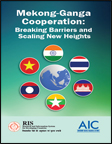 Mekong-Ganga Cooperation: Breaking Barriers and Scaling New HeightsThe Mekong-Ganga Cooperation (MGC) promotes intra-regional collaboration among Cambodia, India, Lao PDR, Myanmar, Thailand and Vietnam in the areas of trade, tourism, culture, education, and transport and communications. This book reviews how MGC cooperation has grown since MGC's inception in 2000, including expansion of their economic and cultural relations. Under India's Act East Policy, MGC has gained further momentum – endorsing a Plan of Action 2016-2018, and planning extended connectivity of the India-Myanmar-Thailand Trilateral Highway to Cambodia, Laos, and Vietnam. This report outlines important discussion points on trade, regional value chains, foreign direct investment, physical and digital connectivity, border connectivity, and cultural relations, to strengthen India and the Association of Southeast Asian Nation linkages through MGC. Author: Research and Information System for Developing Countries and ASEAN-India Centre Year: 2017 Download Tags: ASEAN, India, Southeast Asia, South Asia, Trade, Trade Facilitation Global Energy InterconnectionSustainable energy and climate change are major global concerns, yet three billion people around the world rely on wood, coal, or animal waste for cooking and heating. The interconnection of grids would open up opportunities for resource sharing and bring clean energy to much more of the world. This paper assesses benefits and outlines policy, technical, and economic preconditions for global energy interconnection. It analyzes global transmission scenarios and evaluates their impact on energy supplies and the environment. It also gives recommendations for setting standards, and where stakeholder involvement is necessary. Author: International Electrotechnical Commission Year: 2017 Download Tags: Energy, India, Nepal, Policy, Standardization, Sustainability, Trade, South Asia Implications of Brexit to the Asia-Pacific Region: with a Focus on Least Developed Countries (Trade Insights: Issue No. 20)This issue of Trade Insights, published by United Nations Economic and Social Commission for Asia and the Pacific, discusses how possible Brexit scenarios could adversely affect least developed countries in the Asia-Pacific region. Simulation results show that potential reduction in exports to the United Kingdom for fish, clothes, textiles, footwear, and other key items can range from 16% to 50% of their current export value. According to the study, countries heavily exposed to Brexit-induced risks must analyze the extent of such impact and engage the United Kingdom in discussions in order to limit negative impact. Author: Louis Graham, Arun Jacob, and Anders K. Møller Year: 2017 Download Tags: Asia-Pacific, Least Developed Countries, South Asia, Trade, UNESCAP, India, Bangladesh, Maldives, Myanmar, Nepal, Sri Lanka Asian Development Outlook 2017: Transcending the Middle-Income Challenge The Asian Development Outlook 2017 forecasts 5.7% growth for developing Asia in 2017 and 2018, and 7% and 7.2% for South Asia in 2017 and 2018. Resumption of growth in South Asia follows the brief slowdown in 2016 due to decline in fixed investment and impact of demonitization on trade and commerce. Growth in India is forecast at 7.4% in fiscal 2017 and 7.6% in 2018. In Bhutan, growth is expected to accelerate to 8.2% in 2017, with expanded investment in hydropower for export, and added capacity in electricity generation. Nepal's growth is expected to revive to 5.6% in 2017 with increased post-earthquake reconstruction and more reliable electricity. Author: Asian Development Bank Year: 2017 Download Tags: ADB, India, Bhutan, Nepal, South Asia 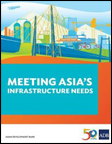 Meeting Asia's Infrastructure NeedsThis report estimates infrastructure investment needs in Asia and the Pacific for 2016-2030, updating the Asian Development Bank's assessment for 2010-2020 published in 2009. The report places developing Asia's investment needs at $26 trillion to maintain its growth momentum, eradicate poverty, and respond to climate change. While developing Asia's infrastructure, including its transport network and electricity generation capacity, has improved significantly over the years, it remains far from adequate – lack of reliable power supply continues to constrain economic growth and traffic congestion results in lost productivity, wasted fuel, and human stress. The report recommends $14.7 trillion investment for power and $8.4 trillion for transport. South Asia requires investments valued at 8.8% of gross domestic product. Author: Asian Development Bank Year: 2017 Download Tags: Asia, South Asia, Energy, Transport, Bangladesh, Bhutan, ADB, India, Maldives, Myanmar, Sri Lanka, Nepal South Asia’s Turn: Policies to Boost Competitiveness and Create the Next Export PowerhouseWill South Asia become the next global factory? By 2030 more than a quarter of the world’s working adults will live in South Asia. As the work force ages and labor costs rise in China and other East Asian countries, many eyes turn to South Asia. According to this report, to realize the region’s potential, countries in South Asia should increase regional and global integration, take advantage of agglomeration economies, strengthen firm capabilities, and improve the business environment. Author: Gladys Lopez‐Acevedo, Denis Medvedev, and Vincent Palmade Year: 2017 Download Tags: Bangladesh, India, Regional Integration, South Asia, Trade, WB 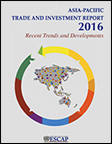 Asia-Pacific Trade and Investment Report 2016: Recent Trends and DevelopmentsThe Asia-Pacific Trade and Investment Report 2016 reports that the Asia-Pacific region is still the largest exporter of goods globally, with a share of 40%. Its share in commercial services trade is also on the rise, while restrictiveness of services trade has not increased. Foreign direct investment (FDI) inflows is also growing at a much faster pace compared to the global average, with special economic zones being used as one of the modalities to attract FDI. India, in particular, has been attracting an increasing portion of FDI inflows, both from outside and inside the region. While economies in Asia and the Pacific continue to make progress toward trade facilitation, there are still huge gaps among subregional economies, with much needing to be done to reduce trade costs. Furthermore, efforts undertaken to reduce trade costs through trade facilitation have been partially offset by imposition of a large number of new trade distortive measures globally and regionally, with most of these new measures falling under the non-tariff category. Author: United Nations Economic and Social Commission for Asia and the Pacific Year: 2016 Download Tags: Export, Trade Facilitation, Non-Tariff Measures, FDI, South Asia, India, Special Economic Zones Competitiveness of South Asia’s Container Ports: A Comprehensive Assessment of Performance, Drivers, and CostsAs a result of inefficiencies in South Asia’s container ports, the average cost of exporting or importing a container in the region is more than double that in East Asia. Better port logistics could help increase trade, diversify exports, attract more foreign direct investment, and spur economic growth. As container traffic continues to grow in South Asia, the best way to improve port performance is by increasing productivity. This report examines the performance of the 14 largest container ports in the region, identifying key drivers of port performance and examining differences in performance across ports. Author: Matías Herrera Dappe and Ancor Suárez-Alemán Year: 2016 Download Tags: Customs, Economic Growth, FDI, Infrastructure, Investment, South Asia, Trade, WB Connecting Bangladesh: Economic Corridor NetworkEconomic corridors anchored on transport connectivity could significantly boost Bangladesh's economic growth. This paper presents a new set of corridors for Bangladesh – a nine-corridor comprehensive integrated multimodal economic corridor network that will enhance Bangladesh’s role as land bridge between South Asia and Southeast Asia, and between South Asia and northern Asia. These proposed corridors are designed to sustain robust economic growth over the long term by improving regional connectivity, transit, and integration, alongside trade facilitation measures. Author: Mohuiddin Alamgir Year: 2016 Download Tags: Economic Corridor, Bangladesh, South Asia, Southeast Asia, Connectivity, Transport, Trade Facilitation, ADB RCI Leveraging Urbanization in South Asia: Managing Spatial Transformation for Prosperity and LivabilityAs South Asian economies improve, they have the potential to greatly improve their prosperity and livability for the people of the region by improving their state of urbanization. Messy and hidden urbanization that leads to slums and sprawls is the result of failure to address congestion constraints arising from rapid growth of urban populations. This book examines the state of South Asia's urbanization – it reviews gaps in markets and policies that have hindered its proper growth, and discusses key policy areas that must be undertaken, including improvement in housing provisions, infrastructure, and basic services. Author: Peter Ellis and Mark Roberts Year: 2016 Download Tags: Economic Corridor, Urban Development, Governance, Sustainability, South Asia, Social Services South Asia Economic Focus, Fall 2016: Investment Reality CheckSouth Asia continues on a path of gradual acceleration in 2016, led by a solid India. However, amid the resilience to external headwinds, including China’s slowdown and uncertainty surrounding monetary policy in advanced economies, South Asia is starting to feel the effect of slowing remittance flows or waning oil price dividends. Against this backdrop, this World Bank publication forecasts growth for the region at 7.1% in 2016, with its medium-term performance strongly dependent on investment and export turnout. India is set to grow at 7.6% in 2016, with the same speed as in 2015, but may increase its pace again in 2017 to 7.7%. The report highlights how private investment is a key future growth driver across South Asia that could help further boost the pace of economic activity. Author: World Bank Year: 2016 Download Tags: India, South Asia, Investment, Economic Growth, WB, Export 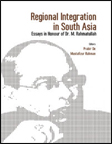 Regional Integration in South Asia: Essays in Honour of Dr. M. RahmatullahBuilding efficient transport linkages within and across countries in South Asia is crucial to development of production networks and value chains, and promotion of trade and investment. This collection of essays honors Dr. M. Rahmatullah, who championed the cause of multimodal connectivity in South Asia for seamless movement of goods across Asia, and dreamt of building an integrated South Asia through corridors and gateways to be connected with pan-Asian transport networks. A valuable resource for policymakers, academics, and practitioners working on issues of South Asian regional integration, this book looks at progress made on facilitating trade and enhancing connectivity in the region, assesses policy priorities, implementation imperatives, and emerging challenges to South Asian trade and integration, and gives recommendations on further strengthening South Asian integration. Author: Prabir De and Mustafizur Rahmant Year: 2016 Download Tags: Transport, Trade, Trade Facilitation, Connectivity, South Asia, South Asian Economic Union Improving Energy Efficiency in South AsiaThis paper examines areas where the efficiency of South Asian power systems could be significantly increased, such as the operation of thermal power plants and transmission systems. It also looks at ways to increase conservation by users through time-of-use electricity tariffs, appliance standards, and demand control through smart metering. It concludes that South Asia has a significant potential for energy efficiency improvement in the power sector, which can be realized by implementing policies and programs that can readily complement the existing institutional framework. Author: Priyantha Wijayatunga and Tilak Siyambalapitiya Year: 2016 Download Tags: Energy, ADB, South Asia, ADB RCI Disaster Risk Financing in BangladeshBangladesh is disaster-prone, with frequent severe floods and cyclones. Applying appropriate disaster risk financing is key to minimizing economic impacts from disasters, and sustaining the country’s development. This paper analyzes economic losses in Bangladesh caused by natural disasters from 2000 to 2013 and the funding gap, due in part to insufficient financial preparedness in disaster risk management. Author: Mayumi Ozaki Year: 2016 Download Tags: ADB, Bangladesh, South Asia The Little Data Book 2016The Little Data Book 2016 offers a quick reference of World Development Indicators 2016, presenting the latest available data for World Bank member countries and other economies in 214 tables. Regional and income group aggregates are also covered in the 12 summary tables, including South Asia. The book includes selected indicators used to monitor progress toward the Sustainable Development Goals. Author: World Bank Year: 2016 Download Tags: Sustainability, South Asia, Economic Growth 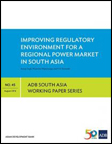 Improving Regulatory Environment for a Regional Power Market in South AsiaCountries in South Asia continue to experience poor access to energy, energy shortages, and concerns for energy security. Bilateral energy trading, with its limited scope, leaves untapped the vast economic, reliability, and environmental benefits of energy cooperation in the region. Improving access to modern energy sources through regional cooperation contributes toward economic growth, and better and more sustainable living conditions in South Asia. Regional energy cooperation supports the development of regional primary energy sources to generate electricity, cross-border transmission infrastructure, and a regional framework that will coordinate energy resource development and trade of electricity across the region. However, this will only be possible with appropriate policies and harmonized legal and regulatory frameworks in all necessary systems. Experience across the world indicates that such legal and regulatory changes can be accomplished successfully. Author: Anoop Singh, Priyantha Wijayatunga, and P. N. Fernando Year: 2016 Download Tags: Energy, Regional Cooperation, South Asia, ADB RCI SARSO News Volume 2, Issue 2The South Asian Regional Standards Organization (SARSO) newsletter features updates on SARSO events and activities. This issue highlights initiatives by SARSO to harmonize standards and improve conformity assessment in the region through workshops, and also meetings of its sectoral technical committees. It also discusses the Cooperation Agreement signed by SARSO and the International Organization for Standardization, to help facilitate the flow of goods and services, and participation of SARSO in a meeting organized by the private sector on 'Promoting Trade in Bangladesh-Bhutan-India-Nepal' region. Author: South Asian Regional Standards Organization Year: 2016 Download Tags: Standards, Trade Facilitation, SAARC, BBIN, South Asia Asian Development Outlook 2016 Supplement: Asia's Growth Prospects Undimmed by Brexit VoteRecent global developments have prompted revisions to developing Asia's 2016 and 2017 growth outlook, as published in March in Asian Development Outlook 2016 (ADO 2016). Uncertainty following the British vote to leave the European Union chilled already tepid recovery in the euro area. While developments have affected developing Asia’s currency and stock markets, its impact on the real economy in the short term is expected to be small. This Supplement expects the region to expand by 5.6% in 2016 and 5.7% in 2017. India has shrugged off global headwinds and is expected to grow by 7.4% in 2016 and 7.8% next year. South Asia as a whole will be the region’s fastest growing subregion. Author: Asian Development Bank Year: 2016 Download Tags: ADB, South Asia, Development The Little Green Data Book 2016The Sustainable Development Goals (SDGs) put environmental concerns on par with economic and social ones. The environment cuts across all the SDGs and is directly reflected in at least seven goals. The 2016 Little Green Data Book provides 50 indicators for 200 countries. Several indicators have the potential to measure progress on the SDGs as well as highlight important trends in the environment more broadly. The indicators are part of the larger World Development Indicators compiled annually by the World Bank from many different data sources. Author: World Bank Group Year: 2016 Download Tags: Energy, Environment, South Asia, WB 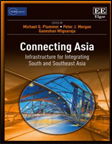 Connecting Asia: Infrastructure for Integrating South and Southeast AsiaThis book contains background papers prepared for the Asian Development Bank and the Asian Development Bank Institute joint study, 'Connecting South Asia and Southeast Asia.' It emphasizes the potential contribution to growth that greater connectivity—through better transport and energy infrastructure and improved soft infrastructure, including trade facilitation—between South Asia and Southeast Asia can foster. With benefits including greater participation in global supply chains for South Asia; lower trade costs; and increase in inter- and intraregional trade, the book underscores that, at a juncture where closer regional integration can secure sustainable and inclusive growth for economies in the two regions, specific policies should be examined and considered to enable both regions to maximize gains from greater integration. Author: Michael G. Plummer, Peter J. Morgan, Ganeshan Wignaraja, eds. Year: 2016 Download Tags: South Asia, Southeast Asia, Trade Facilitation, Transport, Energy, ADB, Economic Corridor, Bangladesh, India, Sri Lanka, ADB RCI Asian Development Outlook 2015 Supplement: Growth Holds Its Own in Developing AsiaThis Supplement maintains growth forecast for developing Asia at 5.8% in 2015 and 6.0% in 2016. In South Asia, economic outlook remains optimistic, with the region on track to meet Update projections of 6.9% in 2015 and 7.3% in 2016. India's economic expansion balances a slowdown in Bhutan—owing to weaker sales of hydropower—and the Maldives in 2015, and in Nepal in 2016—due to unfavorable weather and unforeseen delays in earthquake-related reconstruction. Growth projections for Bangladesh and Sri Lanka remain in line with those in the Asian Development Outlook Update. Author: Asian Development Bank Year: 2015 Download Tags: ADB, South Asia, Bangladesh, Bhutan, India, Maldives, Nepal, Sri Lanka 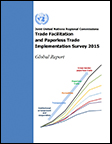 Joint UNRCs Trade Facilitation and Paperless Trade Implementation Survey 2015: Global ReportThis Report features results of the first UNRCs Joint Survey on Trade Facilitation and Paperless Trade Implementation, providing an overview of the current state of trade facilitation implementation in 119 economies across 8 regions worldwide. Though this Joint Survey finds that global average implementation rate of trade facilitation measures considered in the report stands at 52.9%, South Asia ranks below 40%. In the authorized operators and establishment and publication of average release times - categorized under the formalities measures - South Asia ranks below 10%. However, the region fares better in the institutional and cooperation measures, in particular with the recommendation to establish National Trade Facilitation Committees, with this measure most implemented in South Asia. The Report ranks India as the region's top performer in implementation of trade facilitation measures. Author: United Nations Regional Commission Year: 2015 Download Tags: Trade Facilitation, South Asia, Customs Regional Transport Infrastructure: Mapping Projects to Bridge South Asia and Southeast AsiaThis Asian Development Bank (ADB) brief highlights the critical role of transport infrastructure in bridging South Asia and Southeast Asia. It maps details of economic corridors and highways, railroads, and seaports, and identifies priority transport investment projects needed to link the two subregions. While an investment of $986 million in road transport and $2.3 billion in sea ports may be needed to create proper connectivity between the two regions, the study's conservative estimate of potential benefit ranges from $89 billion to $358 billion over the next decade - demonstrating how investment in infrastructure can pay huge dividends in the medium- and longterm. Author: Peter Morgan, Mike Plummer, and Ganeshan Wignaraja Year: 2015 Download Tags: Transport, South Asia, Southeast Asia, ADB RCI Lessons for South Asia from the Industrial Cluster Development Experience of the Republic of KoreaGrowth of manufacturing is crucial for economic growth and poverty reduction. This report highlights the industrial cluster development policy of the Republic of Korea, including its success factors in terms of policy implementation, and the promotion of industrial cluster development, drawing lessons that could enhance industrial growth in South Asia. It discusses how the government encouraged increase in exports through relevant policies and adapted to more technology- and knowledge-intensive industries which required innovation-driven policies. The experience outlined in the report could benefit large-scale industrial promotion in South Asia, such as the Economic Corridor Program in India. Author: Jong-il Kim Year: 2015 Download Tags: South Asia, Industrialization, Economic Corridor, Trade, ADB, India, Bangladesh, Sri Lanka, ADB RCI Building Firm-level Trade Competitiveness in Emerging EconomiesThis paper -- produced under the E15 Initiative and implemented jointly by the International Centre for Trade and Sustainable Development and World Economic Forum -- seeks to understand the framework of competitiveness and its implications for international trade. It discusses issues related to firm-level competitiveness, including the determinants; quality tools and models to address it, especially in developing economies and small and medium enterprises (SMEs); importance of diffusion and learning with a focus on SME growth; and specific policy interventions to improve firm-level competitiveness. Author: Sharmila Kantha Year: 2015 Download Tags: Firms, SME, Trade, Development, Sustainability, India, South Asia, Energy 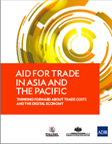 Aid for Trade in Asia and the Pacific: Thinking Forward About Trade Costs and the Digital EconomyAid for Trade (AfT) flows have increased each year since 2006 in Asia and the Pacific. While regional aggregate trade costs continue to fall, many subregions still struggle with trade costs that are substantially higher than the global average. This report highlights and explores how AfT contributed to these emerging trends in Asia and the Pacific and how to continue to address trade costs moving forward. Among the subregions, the Pacific (along with South Asia) has made the greatest improvements in the Logistics Performance Index from 2007-2014. Recent exporter surveys reveal a movement toward niche products and leveraging of e-commerce as a means to overcome cost and distance. Emerging digital technologies such as e-commerce further offers a new set of opportunities for economies in the region to grow through trade. Author: Asian Development Bank Year: 2015 Download Tags: Aid for Trade, Asia-Pacific, ICT, South Asia, Trade, Bangladesh, Bhutan, India, Sri Lanka, Agriculture, Energy, Transport 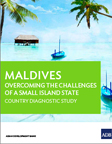 Maldives: Overcoming the Challenges of a Small Island State – Country Diagnostic StudyThe Maldives has propelled itself to middle-income status despite the geographic constraints and challenges of a small-island state. It has one of the lowest poverty rates in South Asia, although wide regional disparities in poverty rates and high-income inequality continue to be a concern. Growth – primarily driven by the tourism sector – has also been vulnerable to external shocks. As the Maldives moves toward a more sustainable and inclusive growth strategy, transport infrastructure is critical to help address the country’s connectivity issue and reduce the cost of doing business. This report identifies the critical constraints to inclusive growth in the Maldives and provides policy recommendations to sustain economic growth and hasten poverty reduction. Author: Asian Development Bank Year: 2015 Download Tags: Maldives, Small Island Developing States, Transport, Connectivity, Policy, Poverty Reduction, South Asia, Tourism SAARC: The Way AheadThis Observer Research Foundation Issue Brief examines the South Asia Association for Regional Cooperation as a regional grouping that is almost three decades old. It discusses trade arrangements such as the South Asian Preferential Trading Arrangement aimed towards a higher level of intraregional trade liberalization and economic cooperation, including the South Asia Free Trade Area for reduction of Customs duties on traded goods. The paper further studies areas of energy, connectivity, foreign direct investment, trade in services and subregional cooperation. The South Asia Subregional Economic Cooperation Program is offered as one of the steps in the direction of having a viable option for subregional cooperation. Author: Jayshree Sengupta Year: 2015 Download Tags: Regional Cooperation, SAARC, Trade, Connectivity, Energy, FDI, Investment, Free Trade Agreements, Services, South Asia 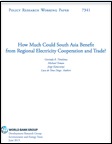 How Much Could South Asia Benefit from Regional Electricity Cooperation and Trade?This paper assesses the potential economic benefits of cross-border electricity cooperation and trade in South Asia from 2015 to 2040. It focuses on the possibilities of unlimited power flow across borders in response to regional demands and investment in generation and transmission to cost-effectively meet those demands. The study quantifies the potential economic benefits that South Asia could reap if the countries engage with full regional electricity trade and cooperation. Among South Asia Subregional Economic Cooperation countries, Bhutan and Nepal have the potential to cost-effectively supply electricity from hydroelectric resources in excess of their own demands; Bangladesh and India are likely to become more dependent on higher-cost coal as well as natural gas to generate electricity. The countries of the South Asia region also have non-coincident demand peaks across the year, implying gains from trade. Author: The World Bank Year: 2015 Download Tags: Energy, South Asia, Trade, Bangladesh, India, SASEC 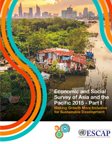 Economic and Social Survey of Asia and the Pacific 2015The 2015 edition of ESCAP’s Economic and Social Survey of Asia and the Pacific highlights inclusive growth as a prerequisite for meeting the Millennium Development Goals and critical for effective implementation of the sustainable development agenda post-2015. It also contains proposals to improve the pattern of public expenditures and increase access to financial services. Economic growth in South and South-West Asia increased in 2014, led by stronger macroeconomic performance in India, but remained far below its pre-crisis pace. While the near-term outlook is optimistic and conditional on continued domestic reform in large economies, limited intraregional trade within the sub-region could limit positive spillovers into relatively smaller economies. A key reform area is broadening the tax base and stemming of tax evasion to lower public borrowing and help address severe power shortages. Author: United Nations Economic and Social Commission for Asia and the Pacific Year: 2015 Download Tags: Asia-Pacific, Economic Growth, South Asia Asian Development Outlook 2015 Supplement: Growth Prospects Soften for Developing AsiaThis Supplement revises growth projections for developing Asia published in the Asian Development Outlook (ADO) 2015 in March, as slower-than-expected recovery in the United States and moderating growth in the People’s Republic of China weigh on the region’s prospects. Economic outlook for South Asia is stronger growth in the subregion as a whole in 2015 than forecast in ADO 2015, now bumped up slightly to 7.3% from 7.2%. The projection for 2016 remains the same at 7.6%. By individual countries, stronger growth is estimated for Bangladesh in FY2015, but slower growth is projected for the Maldives and earthquake-struck Nepal. Author: Asian Development Bank Year: 2015 Download Tags: Development, Economic Growth, South Asia A Critical Disconnect: The Role of SAARC in Building the DRM Capacities of South Asian Countries This report evaluates the disaster risk management (DRM) efforts of the South Asian Association for Regional Cooperation (SAARC) in the last ten years as a regional organization, and assesses its impact in supporting the DRM national capacities of member states. Published after the April 2015 earthquake in Nepal, the publication underscores the critical role SAARC plays in building a common regional vision for DRM. It recommends focusing on priority activities that can assist member states in implementation of policies at a sub-national level; opening itself to support by external donors; and enhancing its training program through regional training of trainers by the SAARC Environment and Disaster Management Centre. Author: Stacey White Year: 2015 Download Tags: SAARC, Disaster Risk, South Asia Clean Energy and Access to Infrastructure: Implications for the Global Trade SystemThis paper focuses on how international trade rules could better accommodate renewable energy trade through fixed infrastructure. It explains the World Trade Organization disciplines relevant to trade in clean energy via fixed infrastructure, in particular General Agreement on Trade in Services disciplines on energy services and General Agreement on Tariffs and Trade transit rules. Finally, it suggests policy options to adopt existing rules to the challenges of integrating clean energy transported via fixed infrastructure. Author: International Centre for Trade and Sustainable Development Year: 2015 Download Tags: Energy, Trade, WTO, India, South Asia, Sustainability, Tariff Cross-Border Electricity Cooperation in South AsiaStrengthening cross-border electricity cooperation in South Asia can be part of the solution for providing adequate and reliable electricity. This World Bank Policy Research Working Paper reviews the status of cross-border electricity cooperation in South Asia, identifies key regional-level barriers to expand cross-border cooperation and trade in South Asia, and discusses the extent to which current domestic sector policies impede greater cross-border electricity cooperation. Finally, the findings offer policy recommendations on increased cross-border trade and cooperation. Author: Anoop Singh, Tooraj Jamasb, Rabindra Nepal, and Michael Toman Year: 2015 Download Tags: Energy, Regional Cooperation, Regional Trade, Bangladesh, Bhutan, India, Maldives, Nepal, South Asia, Sri Lanka, Trade, Trade Policy, WB Key Recommendations: South-Asia Consultation on the Post-2015 Development AgendaThe South Asian Association for Regional Cooperation, the United Nations Development Programme, the United Nations Economic and Social Commission for Asia and the Pacific, and the Asian Development Bank organized the South Asia Consultation on the Post-2015 Development Agenda in Nagarkot, Nepal on 26-28 August 2014. This Nagarkot Statement contains the eight guiding principles for future goals, key messages and recommendations on South Asia’s development priorities, financing for a post-2015 development agenda to support sustainable development, and technology access, including data, monitoring and accountability. Author: United Nations Economic and Social Commission for Asia and the Pacific Year: 2015 Download Tags: South Asia, Sustainability, ICT Connecting South Asia and South East Asia This book analyzes how closer regional connectivity and economic integration between South Asia and Southeast Asia can benefit both subregions. It aims to build a broad case for increased connectivity between the two regions and identify specific projects that have high potential to fulfill this objective. This joint study focuses on both “hard” infrastructure and associated “soft” infrastructure, including tariffs and non-tariff barriers, trade and transport facilitation, energy trading, and infrastructure investment and financing. It further provides a canvas for considering strategic cross-border infrastructure investments and policy reforms. Author: Asian Development Bank Institute and Asian Development Bank Year: 2015 Download Tags: South Asia, Southeast Asia, Connectivity, Economic Corridor, Transport, Trade Facilitation, Bangladesh, India, Sri Lanka Asian Development Outlook 2015: Financing Asia’s Future GrowthThe Asian Development Outlook 2015 forecasts that the 6.3% rate of gross domestic product expansion achieved in 2014 will continue into 2015 and 2016. This is supported by a strengthening recovery in major industrial economies and soft global commodity prices. It also projects growth in South Asia to
accelerate to 7.2% in 2015, and 7.6% in 2016. Developing Asia needs a deep, robust financial sector to sustain growth, and policymakers are challenged to ensure inclusive financial sector development and financial stability to enhance growth and equity. Author: Asian Development Bank Year: 2015 Download Tags: Asia-Pacific, South Asia, Financial Sector Electricity Consumption, Output, and Trade in BhutanThis ADB South Asia Working Paper examines the relationship between electricity consumption, international trade, and economic growth using an augmented production function framework. The findings show that Bhutan is energy-dependent and can promote economic growth through future investment in hydropower. More specifically, the results show that a 1% increase in (i) electricity consumption generates 0.03%-0.05% increase in output, (ii) total trade results in 0.5% increase in output, (iii) trade openness results in 1% increase in output. Author: Hooi Hooi Lean and Russell Smyth Year: 2015 Download Tags: Energy, Trade, Bhutan, ADB, South Asia, Hydropower, ADB RCI 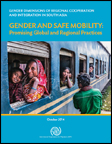 Gender Dimensions of Regional Cooperation in South Asia: Gender and Safe Mobility – Promising Global and Regional PracticesThis technical report analyzes global practices related to gender equality and safe migration, and their applicability to the context of South Asia. "Hard" aspects, such as physical infrastructure and equipment including border infrastructure, passenger holding facilities and surveillance cameras, and "soft" aspects, such as regional, bilateral and/or country-specific policies, programs, mechanisms and institutional linkages of safe mobility, are presented. The report also presents national policies and procedures that promote safe mobility. Given the lessons drawn from the reviewed policies and practices, it highlights the need for stronger evidence-based approaches in understanding the complex experience of women migrant workers, and identifies the need for more regular peer exchange through periodic regional dialogues of key stakeholder groups. Author: International Organization for Migration Year: 2014 Download Tags: Gender, Migration, South Asia, Bangladesh, Bhutan, India, Nepal, Transport, Trade 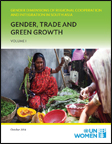 Gender Dimensions of Regional Cooperation in South Asia: Gender, Trade and Green Growth (Volumes I and II)This technical report presents an analysis of the interconnection between gender equality, regional trade and sustainable development in selected areas of four South Asian countries. In general, the report found women's contributions to total exports of all countries to be low, and in green exports to be lower. It identifies constraints and challenges, such as limited training in entrepreneurship, gender stereotypes related to green trade, existing gaps in policy framework, and weak access to technology, hindering women's participation in three green trade industries - agriculture and agro-processing, renewable energy, and ecotourism. The report looks at possible entry points for women, and recommended a list of actions to tap these identified entry points, including the need for greater exchange and cross-fertilization of experience among associations of women entrepreneurs and women’s chambers of commerce in South Asia. Author: Shreyasi Jha, Ritu Dewan, Amee Misra, Saloni Singh, Navanita Sinha, Maheen Sultan and Sonam Tobgay Year: 2014 Download Tags: Gender, Trade, Sustainability, South Asia, Bangladesh, Bhutan, India, Nepal Developing Economic Corridors in South Asia This book describes key conditions for transforming transport corridors into economic corridors and establishes the rationale for developing economic corridors, and the related benefits from production value chains along those corridors. It further emphasizes the significant potential of economic corridors in South Asia, particularly those being developed under the South Asia Subregional Economic Cooperation Program. The chapters highlight the impact of trade barriers on bilateral trade and present case studies on trade facilitation in South Asia. Countries in the subregion would benefit by working closely to exploit the full economic potential of economic corridors. Author: Asian Development Bank Year: 2014 Download Tags: Economic Corridor, South Asia, Trade Facilitation, Bangladesh, India, Sri Lanka, ADB, SASEC, Bilateral Trade, Transport 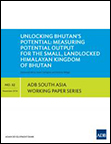 Unlocking Bhutan’s Potential: Measuring Potential Output for the Small, Landlocked Himalayan Kingdom of Bhutan The hydropower sector has driven Bhutan's economic growth in the past two decades with growth rates averaging 7.9%. Yet, the economy has not been invulnerable to market fluctuations and external shocks. This ADB South Asia Working Paper analyzes how Bhutan can create sustainable and inclusive growth, alongside the continuous expansion of its hydropower industry. It examines how certain policies can impact Bhutan's potential growth over 2013–2030. Results show that higher investment in education, health, and efforts to diversify its economic base—including enhancement of new industries with linkages to regional and global value chains—can further drive economic growth and improve the country's living standards. Author: Sabyasachi Mitra, Sarah Carrington, and Anthony Baluga Year: 2014 Download Tags: Bhutan, Energy, Economics, Hydropower, ADB, South Asia, Sustainability, Global Value Chains, Economic Growth Regional Transit Agreement in South Asia: An Empirical InvestigationThis discussion paper published by the South Asia Watch on Trade, Economics and Environment assesses the potential gains of a sub-regional transit arrangement and the removal of other border-trade barriers, particularly the eastern South Asia sub-region (Bangladesh, Bhutan, India and Nepal). It also discusses the link between transit and trade flows, provides profiles of intra-regional transit trade and current transit arrangements in South Asia, and identifies efficient regional transit corridors using linear programming or the Data Envelopment Analysis model. Author: Prabir De and Arvind Kumar Year: 2014 Download Tags: South Asia, Trade, Transport, Economics, Economic Corridor, SASEC, SAARC, UNESCAP, Customs, Harmonisation, Bangladesh, Bhutan, India, Nepal, Maldives, Sri Lanka Global Production Networks and Economic Corridors: Can They Be Drivers for South Asia’s Growth and Regional Integration?This Asian Development Bank South Asia Working Paper examines the role of regional and national economic corridors in facilitating access of South Asian countries to global production networks (GPNs), particularly East Asia and Southeast Asia. It also reviews the state of regional trade integration and examines the nature of engagement in South Asia, specifically India, with its dynamic and high growth GPNs. The paper further identifies key factors that constrain engagement of South Asian countries with East and Southeast Asia in GPN trade. Author: Kunal Sen Year: 2014 Download Tags: South Asia, Global Production Network, Economic Corridor, ADB, Regional Integration, India, Bangladesh, Sri Lanka 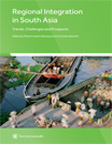 Regional Integration in South Asia: Trends, Challenges and ProspectsThis study presents an assessment of trade and economic cooperation among South Asian nations, explores emerging challenges, and highlights policy issues to foster regional integration. It provides perspectives on potential new areas of cooperation such as investment, regional supply chains, energy, and cross border transport networks. The four areas of focus are: potential gains from South Asian regional integration, key areas for cooperation resulting in effective regional integration, country perspectives of regional cooperation, and case studies on bilateral cooperation. This volume aims to further contribute to policy discourse on effective regional cooperation with perspectives from Bangladesh, India, Maldives, Nepal, Pakistan, and Sri Lanka.
Author: Mohammad A. Razzaque, Yurendra Basnett (Eds.) Year: 2014 Download Tags: South Asia, Regional Integration, Regional Cooperation, Bangladesh, India, Maldives, Nepal, Sri Lanka, Energy NTMs in South Asia: Assessment and AnalysisThe study “NTMs in South Asia: Assessment and Analysis” analyzes how Non-tariff Measures (NTMs) give rise to non-tariff barriers, which are becoming increasingly crucial for advancing trade cooperation among member countries of the South Asian Association for Regional Cooperation, yet remain less-addressed. The study examines export potential and actual export of South Asian countries, and attempts to highlight gains from reduction in transaction costs in bilateral trade. It also notes that initiatives for trade facilitation reforms in South Asia at the regional level remain low in incentives and have yet to produce significant results. The study closes with several recommendations for reducing and eliminating NTMs. Author: Selim Raihan, Mostafa Abid Khan, and Shaquib Quoreshi Year: 2014 Download Tags: Trade Facilitation, Trade, SAARC, Bangladesh, Bhutan, India, Maldives, Nepal, South Asia, Sri Lanka Review of Maritime Transport 2014The Review of Maritime Transport is an annual UNCTAD flagship publication since 1968. It provides analysis of structural and cyclical changes affecting seaborne trade, ports and shipping, freight markets, and transport and regulatory frameworks. It further presents statistics, data, and insights on ownership of the world fleet, with South Asia dominating the market for ship recycling. This year’s special chapter focuses on the challenges faced by the world’s Small Island Developing States (SIDS) and reviews shipping-related challenges resulting from SIDS size, remoteness, and exposure to natural hazards, including impacts of climate change. Author: United Nations Conference on Trade and Development Year: 2014 Download Tags: Transport, Ports, Small Island Developing States, UNCTAD, Trade, South Asia, Bangladesh, India, Maldives, Sri Lanka SASEC Website BrochureThis promotional brochure for the SASEC website features the web portal as a one-stop shop for information on SASEC activities, events, projects, and knowledge materials. The SASEC website seeks to build a dynamic discussion platform and repository of data on regional cooperation. Author: Asian Development Bank Year: 2014 Download Tags: SASEC, Knowledge Product, ICT, ADB, Bangladesh, Bhutan, India, Maldives, Nepal, South Asia, Transport, Trade Facilitation, Energy 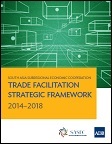 SASEC Trade Facilitation Strategic Framework 2014-2018The South Asia Subregional Economic Cooperation (SASEC) Trade Facilitation Strategic Framework 2014-2018 builds on the momentum of member countries over recent years in forging ahead with many significant improvements to facilitate, and ultimately increase, trade in the subregion and with the rest of the world. It supports the mission of the SASEC Transport and Trade Facilitation Strategy “to promote the prosperity of the subregion by facilitating the efficient movement of trade across the borders”, and focuses on five priority areas: customs modernization and harmonization; standards and conformity assessment strengthening; cross-border facilities improvement; through-transport facilitation; and institution and capacity building. Author: Asian Development Bank Year: 2014 Download Tags: SASEC, Trade Facilitation, Regional Cooperation, Transport, Trade, Customs, Standards, Harmonisation, Regional Integration, ADB, Bangladesh, Bhutan, India, Maldives, Nepal, Sri Lanka, South Asia, ADB RCI World Trade Report 2014 – Trade and Development: Recent Trends and the Role of the WTOThis annual publication highlights the relationship between trade and development, including changes since the start of the millennium. It identifies four key trends that altered the way trade affects development outcomes – accelerated economic growth in developing countries, expansion of global value chains, increase in agricultural and natural resource prices, and global nature of macroeconomic shocks. This report also explores how these trends have reshaped the role of trade in facilitating development and how recent development gains allow developing countries to adapt and mitigate risks. Author: World Trade Organization Year: 2014 Download Tags: WTO, Global Value Chains, Trade, Economic Growth, Agriculture, Trade Facilitation, Development, Bangladesh, Bhutan, India, Maldives, Nepal, South Asia, Sri Lanka South Asia Economic Focus: The Export OpportunityThis bi-annual report presents the recent economic developments, outlook, and policy of the following South Asian countries – Afghanistan, Bangladesh, Bhutan, India, the Maldives, Nepal, Pakistan, and Sri Lanka. It highlights developing country growth as fairly robust. Meanwhile, India’s growth rate is slowly increasing and its inflation rate declining. South Asian economies solidified their external positions by easing pressures to finance current account deficits, yet face domestic challenges such as reducing fiscal risks, supporting higher levels of investment, and sustaining export growth. Author: The World Bank Year: 2014 Download Tags: South Asia, Trade, Economics, WB, Bangladesh, Bhutan, India, Maldives, Nepal, Sri Lanka Asian Development Outlook 2014 Update: Asia in Global Value ChainsAs developing Asia continues along a stable growth path, India maintains a 5.5% growth forecast for 2014 and shows promise of a turnaround. Reforms are envisioned for 2015, including a forecast 0.3% upgrade to 6.3%. Bhutan recorded the largest current account deficit as a percentage of GDP, due to imports used in construction of several large hydropower projects that will expand its energy export capacity to India. Meanwhile, South Asia is expected to perform with greater momentum in 2015, with a growth forecast upgrade to 6.1% from 5.8%. Most of the improvements in the subregion are from India’s deficit and Bangladesh’s current account. Nepal also shows improved outlook for 2015. Author: Asian Development Bank Year: 2014 Download Tags: South Asia, Global Value Chains, India, Economics, Trade 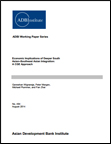 Economic Implications of Deeper South Asian–Southeast Asian Integration: A CGE ApproachHigh tariff and non-tariff barriers, and costly transport links and inefficient trade facilitation measures continue to hamper the growth of trade between South Asia and Southeast Asia. This paper explores whether potential gains from improved connectivity—via Myanmar as inter-regional bridge—justify a high level of investment. Using an advanced computable general equilibrium (CGE) model, reduction of inter-regional tariffs, decreasing of non-tariff barriers by 50%, and cutting down of trade costs between South Asia and Southeast Asia by 15% yields a prediction of 8.9% rise in welfare in South Asia and Southeast Asia, and an increase of 6.4% in gross domestic product by 2030. Author: Ganeshan Wignaraja, Peter Morgan, Michael Plummer, and Fan Zhai Year: 2014 Download Tags: Transport, Trade Facilitation, South Asia, Southeast Asia, Regional Integration, Tariff, Trade, Connectivity, Investment, Myanmar, GDP Assessing the Costs of Climate Change and Adaptation in South AsiaThis book discusses the economic costs and benefits of unilateral and regional actors on climate change adaptation in Bangladesh, Bhutan, India, the Maldives, Nepal, and Sri Lanka. It provides the total economic loss throughout the 21st century and estimates the funding required for adaptation measures to avert potential losses. Huge impacts are likely on vulnerable sectors in the region, with South Asia losing on average nearly 2% of its gross domestic product by 2050. Results of the study will aid climate change adaptation in the region, including initiatives for regional cooperation. Author: Mahfuz Ahmed and Suphachol Suphachalasai Year: 2014 Download Tags: Climate, South Asia, Regional Cooperation, Energy, Bangladesh, Bhutan, India, Maldives, Nepal, Sri Lanka 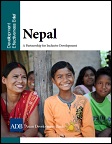 Nepal: Development Effectiveness Brief 2014Nepal has the potential to achieve more inclusive growth and can largely benefit from regional cooperation and integration with its developing neighbors. It is also benefiting from South Asia Subregional Economic Cooperation, a flagship ADB-supported program that promotes economic cooperation and integration in areas of trade facilitation (custom modernization and transport connectivity), power development, trade, and tourism development. This brief further explores ADB’s contribution to inclusive development and poverty reduction, energy, and transport. Exporting energy when surplus is available is one way of meeting seasonal demand by subregional cooperation and power trade. Transport infrastructure is also another key ingredient to equitable, inclusive growth that can address challenges such as lack of market access, inadequate roads, and poor connectivity. Author: Asian Development Bank Year: 2014 Download Tags: Nepal, Regional Cooperation, South Asia, ADB, Connectivity, Energy, Roads, SASEC, Trade, Transport 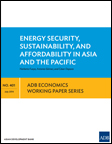 Energy Security, Sustainability, and Affordability in Asia and the PacificEnergy security, sustainability, and affordability from 2010 to 2035 for Asian Development Bank’s Asia and Pacific members are calculated in this working paper, including potential benefits of integrating energy systems regionally. Based on business-as-usual and alternative scenarios, outlook on SASEC member countries by 2035 include (i) dramatic improvement in Bhutan's energy efficiency, (ii) slight decrease in Bangladesh's energy intensity—although carbon dioxide will increase in its primary energy mix, as dependence on fossil fuels rise, and (iii) decrease in energy self-sufficiency of SASEC member countries by 2035, but improved energy affordability. Since renewable energy sources and importation of energy may be capital-intensive, requiring additional tariff support, regional cooperation can enhance affordability and energy security—with Bhutan and Nepal standing to benefit greatly from energy integration in South Asia. Author: Norberto Fueyo, Antonio Gómez, and César Dopazo Year: 2014 Download Tags: Energy, Bhutan, Nepal, Sustainability, Asia-Pacific, ADB, Regional Integration, SASEC, South Asia, Bangladesh, Sustainability, Renewables, Tariff, Regional Cooperation 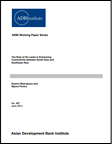 The Role of Sri Lanka in Enhancing Connectivity between South Asia and Southeast Asia As Sri Lanka rebuilds at the end of a 30-year conflict, its progress in improving physical infrastructure—including the Colombo port expansion and other programs for new expressways and road connectivity—has been significant. Yet, the country has seen a sharp decline in its overall exports-to-gross domestic product ratio. How Sri Lanka can benefit from greater connectivity with its neighbors in South Asia and Southeast Asia is discussed in this paper. Trade policies geared towards enhancing regional integration efforts could boost Sri Lanka's economy. Additionally, to lessen the challenges of financing and sustaining implementation of planned infrastructure development efforts, Sri Lanka could also implement a more stringent institutional and regulatory environment encouraging more private sector participation. Author: Dushni Weerakoon and Nipuni Perera Year: 2014 Download Tags: Trade Policy, Trade Facilitation, Sri Lanka, Connectivity, South Asia, Southeast Asia, ADB, Transport, Regional Integration 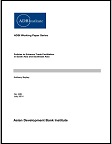 Policies to Enhance Trade Facilitation in South Asia and Southeast AsiaThis Asian Development Bank Institute publication identifies the state of play of trade facilitation and provides an overview of intra- and inter-regional trade in South and Southeast Asia. It highlights key challenges and bottlenecks to effective trade facilitation, ranging from the lack of expert human resources such as information technology specialists in small landlocked countries (Bhutan and Nepal), to the high border transaction costs and severe congestion faced at border crossing points, and the lack of effective dialogue on bilateral enhancement of trade facilitation. Regional initiatives such as the South Asia Subregional Economic Cooperation Program aim to address these challenges through customs modernization and harmonization, automation, and the use of international best practices in border procedures. Author: Anthony Bayley Year: 2014 Download Tags: South Asia, Trade Facilitation, Trade Policy, Southeast Asia, ADB, ICT, Bhutan, Nepal, SASEC, Customs 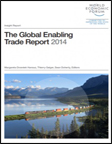 The Global Enabling Trade Report 2014The Global Enabling Trade Report offers a tool to monitor progress on implementing measures for the Trade Facilitation Agreement. Benchmarking the performance of 138 economies in four critical areas, including border administration, the Report takes off from the success of the Bali package by emphasizing measures that facilitate trade at a more practical level, with benefits that significantly outweigh the cost of necessary reforms and produces positive spillover effects on other indicators—market access, infrastructure, and operating environments. Also mentioned are insights on further boosting trade facilitation within the region, such as regional cooperation and sharing of good practices. The Report is intended as a motivator for change at a time of renewed momentum for trade facilitation where windows of opportunities for policymakers to push through trade-enabling measures are open. Author: Margareta Drzeniek Hanouz, Thierry Geiger, Sean Doherty (eds.) Year: 2014 Download Tags: Trade Facilitation, Bangladesh, India, Nepal, South Asia, Sri Lanka 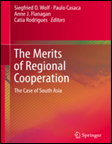 The Merits of Regional Cooperation: The Case of South AsiaThis book makes the case for a re-strengthened South Asian Association for Regional Cooperation (SAARC), arguing that regional integration is a key factor for countries in South Asia to succeed economically and increase confidence among potential foreign investors. SAARC's inroads in improving border crossings, transport routes, and infrastructure are improving weak levels of trade within the region. However, these efforts are insufficient; they need to go hand-in-hand with further improving bilateral relations – and SAARC is in a good position to facilitate these negotiations. Spanning a wide range of subjects, including international relations, strategic affairs, environment, politics and economic issues, the publication aims to show the huge potential of South Asia as a region. Author: Siegfried O. Wolf, Paulo Casaca, Anne J. Flanagan, and Cátia Rodrigues Year: 2014 Download Tags: Regional Cooperation, ASEAN, Bangladesh, Europe, India, SAARC, South Asia SAARC Biz: The Inevitability of South Asia SAARC Biz is a monthly publication of the SAARC Chamber of Commerce & Industry and features a report on the 'Inevitability of South Asia'. While the term 'South Asia' is commonly accepted, it argues that regionalism is far from being implemented on the ground. For instance, SAARC was accepted as a concept of cross-border regionalism but was hobbled due to budget constraints and restrictive mandates. Connectivity across national frontiers is needed to jump-start regionalism and improve lives in the most deprived parts of the Subcontinent. Author: SAARC Chamber of Commerce and Industry Year: 2014 Download Tags: South Asia, Regional Cooperation, SAARC, Industrialization, Regional Integration, Poverty Reduction, Gender, Least Developed Countries, Connectivity, Agriculture, Bangladesh, Youth, India, Environment, Investment, Tourism, Renewables 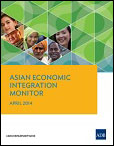 Asian Economic Integration Monitor - April 2014The Asian Economic Integration Monitor, a semiannual review of regional economic cooperation and integration in Asia covers regional economic updates, intraregional trade, financial integration and investment, and the importance of disaster risk financing instruments. The Theme Chapter: Insuring Against Asia’s Natural Catastrophes discusses market solutions and the role of government in developing disaster risk financing and strengthening financial resilience. The economic update section encourages strengthening regional cooperation in surveillance and financial safety nets, and deepening economic links. Inter-subregional trade between each subregion and the rest of Asia is rising, except in South Asia, while financial integration continues to deepen across the region. Author: Asian Development Bank Year: 2014 Download Tags: Regional Cooperation, Regional Integration, South Asia, Disaster Risk, Climate, Bangladesh, Bhutan, India, Maldives, Nepal, Sri Lanka, Transport Lose to Gain: Is Involuntary Resettlement a Development Opportunity?This book examines how displaced persons recover from physical and economic displacement in the South Asian context using resettlement case studies from India, Nepal, and Sri Lanka. Despite improvement in national policies and willingness to enforce good practices, the level of involuntary resettlement good practices in South Asia varies widely. There is need for greater commitment, legal reforms, and adequate resources to ensure that involuntary resettlement becomes a development opportunity for all project-affected persons. Author: Perera, Jayantha (ed.) Year: 2014 Download Tags: India, Nepal, South Asia, Resettlement, Bangladesh, Energy, Renewables, Sri Lanka, Transport 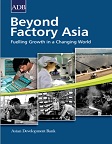 Beyond Factory Asia: Fuelling Growth in a Changing WorldThis paper assesses the challenges of Factory Asia – a model of regional networks connecting production centers in different Asian economies. It forms part of regional and global value chains and constitutes an important source of growth in the region. Regional cooperation is vital to the success of Factory Asia, which calls for greater South-South cooperation to leverage knowledge in domestic manufacturing, allowing countries such as India to leapfrog to higher value chains. For Bangladesh and Sri Lanka with small domestic markets, strategic options include carving out a niche in lower-value manufacturing. The paper further argues that policymakers should be wary of expanding or increasing the number of free trade agreements for the growth or spread of production networks. Author: Asian Development Bank Year: 2013 Download Tags: South Asia, Regional Cooperation, Trade Policy, Manufacturing, Exports, Small and medium enterprises, India, Agriculture, Bangladesh South Asia Energy Security: Challenges and OpportunitiesThe imbalance between the growing demand for energy in South Asia and the countries' uneven energy resources has led to weakened energy security in the region. Import dependence from outside the region has become a costly solution. As countries in South Asia move to expand their economies, fostering cross border energy trade and promoting energy investment opportunities could be a better alternative to resolving the energy deficit. However, energy cooperation within South Asia is challenged by major issues that could impede regional energy trade that is beneficial for all. Author: Bhupendra Kumar Singh Year: 2013 Download Tags: Energy, South Asia, Bangladesh, Bhutan, India, Nepal, Pakistan, Sri Lanka, Trade, Hydropower Reducing Poverty by Closing South Asia's Infrastructure GapThis report takes a critical look at inter-and intra-regional infrastructure of South Asia and explores inequality of access across space and time. It gives an approximate total cost of regional infrastructure needs and investment trends in the South Asia region, along with a proposed framework on ranking of infrastructure needs. The report also examines better usage of existing resources and policy options to help the poorest gain better access to infrastructure.
Finally, it recognizes the enormity of infrastructure deficiencies in South Asia and acknowledges that a good mix of infrastructure investment and supportive reform implementation will enable the region to close the infrastructure gap. Author: Luis Andrés, Dan Biller, and Matías Herrera Dappe Year: 2013 Download Tags: Transport, South Asia, Infrastructure, Energy, Roads, Railway, Water Supply, Bangladesh, Bhutan, Nepal, India, Sri Lanka, Maldives 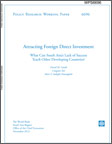 Attracting Foreign Direct Investment: What Can South Asia's Lack of Success Teach other Developing Countries?Despite South Asian nations experiencing increased foreign direct investment (FDI) flows over the past decade by gaining a large share of cross border investments, FDI inflows in South Asian countries still remain the lowest relative to gross domestic product (GDP) among developing country regions. This paper uses an empirical model that accounts for possible trends in convergence in the ratio of FDI to GDP between countries and cross-sectional data for 78 countries from 2000 to 2011. In examining the historical patterns of South Asia’s FDI and its connection with the policy environment, policymakers can identify constraints to FDI and boost potential for broad-based growth. Author: David M. Gould, Congyan Tan and Amir S. Sadeghi Emamgholi Year: 2013 Download Tags: South Asia, Trade Policy, FDI, GDP, Investment, Governance, Transparency, Economic Growth, Financial Sector, Regional Cooperation, Trade UNCTAD Handbook of Statistics 2013This UNCTAD Handbook of Statistics provides essential data for analyzing and measuring world trade, international financial flows, investment, and development. It documents the south-south trend led by developing Asia and reveals how exports among developing countries remain centered in the Asian region. The share of south-south trade in total world exports doubled over the last 20 years to over 25 per cent. Apart from The People's Republic of China and other major petroleum and gas exporters, India is among the countries that have most expanded their south-south trade during the last two decades. Author: United Nations Conference on Trade and Development Year: 2013 Download Tags: South Asia, Statistics, Trade, India Financing Low-Carbon UrbanDevelopment in South Asia: A Post-2012 Context The cities of South Asia are growing at an unprecedented rate. Currently, the region
accounts for 5 of the world's 26 megacities (Delhi, Dhaka, Karachi, Kolkata, and
Mumbai),with Kolkata and Mumbai being the most dense. The urban population in
India is expected to increase by 20.8 percentage points between 2010 and 2050 compared
to 7.8 percentage points in Latin America and the Caribbean. These trends necessitate bold
efforts in project design and financing to steer this rapid urbanization onto an inclusive, green,
and low-carbon urban development path. Author: Asian Development Bank Year: 2013 Download Tags: Climate, Energy, India, South Asia, Kyoto Protocol, Bangladesh, Bhutan, Nepal, India, Maldives, Sri Lanka Climate Action South Asia: Information Update No. 3 (The Economics of Climate Change in South Asia: Adaptation and Impact Assessment)Analyses show that the cost of early action on climate change in South Asia is lower than
the cost of damage brought about by climate change impacts. In physical terms, the region
will face water shortage and agricultural food production losses, which are vital to achieving
poverty reduction and other Millennium Development Goals (MDGs). Author: Asian Development Bank Year: 2013 Download Tags: Economics, Climate, Agriculture, Climate Change, Environment, South Asia, Milennium Development Goals, Sustainability, Bangladesh, Bhutan, India, Nepal, Maldives, Poverty Reduction, Hydropower, Energy Climate Action South Asia: Information Update No. 2 (Economics of Reducing Greenhouse Gas Emissions in South Asia: Options and Costs)The study Economics of Reducing Greenhouse Gas Emissions: Options and Costs in Bangladesh, Bhutan, the Maldives, Nepal, and Sri Lanka reveals excellent opportunities in low-carbon green growth by pursuing resource- and energyefficient technologies that would lower emissions of greenhouse gases at low cost or even cost saving (benefits). Author: Asian Development Bank Year: 2013 Download Tags: Economics, Climate, Climate Change, Economics, South Asia, Bangladesh, Bhutan, Maldives, Sri Lanka, Energy, Environment, Sustainability, ADB, Nepal, Development, Hydropower Climate Action South Asia: Information Update No. 1 (Development in an Era of Accentuated Climate Risks)To steer South Asian economies toward green, low-carbon, and climate-resilient development and for these to take hold in South Asia, the countries need (i) better understanding and greater public awareness of the implications of climate change, (ii) climate risks screening and decision-support tools for identifying actions and managing results, (iii) improved governance and institutional capacities to take necessary actions to manage climate change impacts, (iv) funding sources for such actions, and (v) projects and programs demonstrating positive results that can be scaled up. Author: Asian Development Bank Year: 2012 Download Tags: Economics, Climate, Climate Change, Environment, Sustainability, South Asia, Development, Economic Growth, ADB Regional Cooperation and Integration Through Cross-Border Insfrastructure Development in South AsiaThis paper aims to identify the links between cross-border infrastructure development and poverty reduction. With South Asia being home to around 40% of the world's poor, there is a great need to boost intraregional trade through greater cooperation and integration. Regional integration promises to increase the region's capacity to connect with global production networks and participate in the global economy with greater efficiency. Author: P.V. Srinivasan Year: 2011 Download Tags: Regional Cooperation, Regional Integration, South Asia, Bangladesh, Bhutan, India, Maldives, Nepal, Sri Lanka, Poverty Reduction Gas Hydrates Resource Potential of South AsiaThe amount of natural gas worldwide is estimated to be greater than the entire world’s conventional natural gas resources, which makes gas hydrates a potential energy resource for the future. This document reviews the status of technology regarding exploration and exploitation of gas hydrates, as well as research initiatives by India and other countries of the South Asian Association for Regional Cooperation (SAARC). It also suggests a mechanism for technology transfer and promotion of research and development in the SAARC region. Author: SAARC Energy Centre Year: 2010 Download Tags: Energy, South Asia, SAARC |



